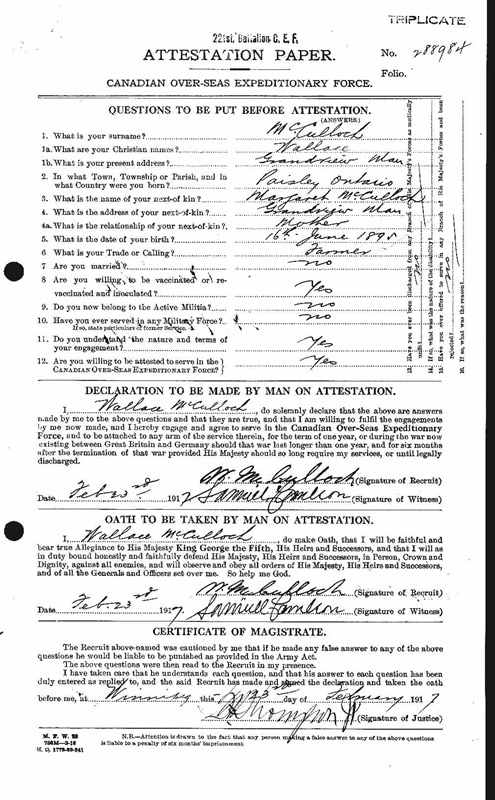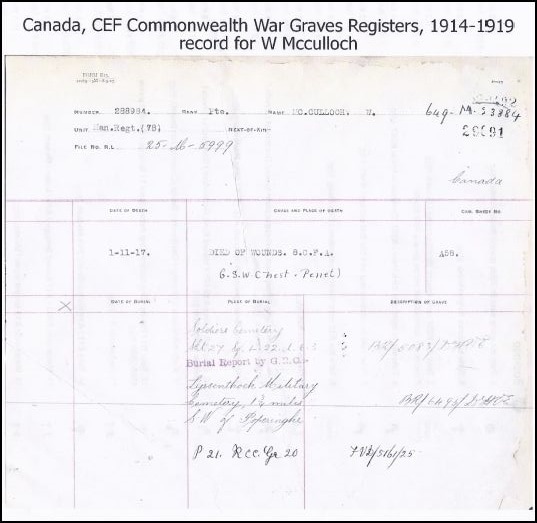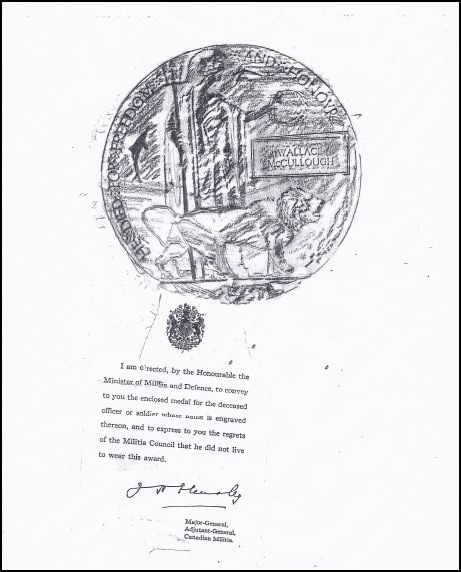Lijssenthoek Military Cemetery
Roll of Honour
I - N
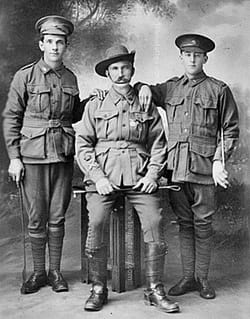
6760 Private
Charles Duff Irwin
13th Bn. Australian Infantry, A. I. F.
16th October 1917, aged 20.
Plot XXI. E. 2.
Portrait of 1620 Private (Pte) Thomas Kennedy Irwin (centre), and two of his sons, 6274 Pte William McIntosh Irwin (left), and Pte Charles Duff Irwin (right). Pte Thomas Kennedy Irwin, embarked with Squadron 6, 2nd Remount Unit, from Sydney on HMAT Orsova on 10 November 1915. He returned to Australia in 1916 before his sons embarked for overseas service. Pte William Irwin, embarked with the 20th Reinforcements, 13th Battalion, from Sydney on HMAT Euripides on 9 September 1916. He returned to Australia in 1917. Pte Charles Irwin embarked with the 22nd Reinforcements, 13th Battalion, from Sydney on HMAT Port Nicholson on 8 November 1916. He died of wounds in Belgium on 16 October 1917, aged 20, and is buried at the Lijssenthoek Military Cemetery, Belgium. A third brother (not in the photograph), 3628 Pte Thomas Kennedy Irwin, enlisted in the 6th Light Horse in 1917 and returned to Australia with the 2nd Light Horse Field Ambulance in 1919.
Charles Duff Irwin
13th Bn. Australian Infantry, A. I. F.
16th October 1917, aged 20.
Plot XXI. E. 2.
Portrait of 1620 Private (Pte) Thomas Kennedy Irwin (centre), and two of his sons, 6274 Pte William McIntosh Irwin (left), and Pte Charles Duff Irwin (right). Pte Thomas Kennedy Irwin, embarked with Squadron 6, 2nd Remount Unit, from Sydney on HMAT Orsova on 10 November 1915. He returned to Australia in 1916 before his sons embarked for overseas service. Pte William Irwin, embarked with the 20th Reinforcements, 13th Battalion, from Sydney on HMAT Euripides on 9 September 1916. He returned to Australia in 1917. Pte Charles Irwin embarked with the 22nd Reinforcements, 13th Battalion, from Sydney on HMAT Port Nicholson on 8 November 1916. He died of wounds in Belgium on 16 October 1917, aged 20, and is buried at the Lijssenthoek Military Cemetery, Belgium. A third brother (not in the photograph), 3628 Pte Thomas Kennedy Irwin, enlisted in the 6th Light Horse in 1917 and returned to Australia with the 2nd Light Horse Field Ambulance in 1919.
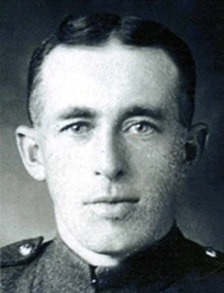
291387 Private
Henry Jackson
1st Canadian Mounted Rifles Battalion
14th November 1917, aged 34.
Plot XXII. DD. 2
Husband of Bessie Jackson, of 33, North Seaton Rd., Ashington, Northumberland, England.
Henry, an electrician by trade, married and a father of two baby daughters, joined the Canadian Army in Winnipeg, Canada and travelled to Liverpool, England, on the SS Olympic (sister ship to the Titanic). After training at Shoreham (Southern England) he was transferred to the 1st CMRB as one of the replacements for the casualties suffered at Vimy Ridge in April 1917. After taking part in the Battle of Passchendaele he was “dangerously” wounded at Capricorn Keep Trench (Pond Farm) by shrapnel from an artillery shell at about 1pm on 14thNovember 1917 while the 1st CMRB was withdrawing from the Reserve Trenches. He arrived at No. 10 Casualty Clearing Station at Remy Siding that evening, after being evacuated to Wieltje ADS by motorised ambulance then to Vlamertinghe Mill MDS and finally to the CCS by a MAC Ambulance. Arriving at the CCS some 5 hours after being badly wounded Henry was immediately placed in the Resuscitation Ward on a heated bed and given a blood transfusion but he never recovered sufficiently to be operated on. As a result he was moved to the Moribund Area where he died later that night.
Research & Photos submitted by Warren Hardman. Henry is my wife’s great grandfather
Henry Jackson
1st Canadian Mounted Rifles Battalion
14th November 1917, aged 34.
Plot XXII. DD. 2
Husband of Bessie Jackson, of 33, North Seaton Rd., Ashington, Northumberland, England.
Henry, an electrician by trade, married and a father of two baby daughters, joined the Canadian Army in Winnipeg, Canada and travelled to Liverpool, England, on the SS Olympic (sister ship to the Titanic). After training at Shoreham (Southern England) he was transferred to the 1st CMRB as one of the replacements for the casualties suffered at Vimy Ridge in April 1917. After taking part in the Battle of Passchendaele he was “dangerously” wounded at Capricorn Keep Trench (Pond Farm) by shrapnel from an artillery shell at about 1pm on 14thNovember 1917 while the 1st CMRB was withdrawing from the Reserve Trenches. He arrived at No. 10 Casualty Clearing Station at Remy Siding that evening, after being evacuated to Wieltje ADS by motorised ambulance then to Vlamertinghe Mill MDS and finally to the CCS by a MAC Ambulance. Arriving at the CCS some 5 hours after being badly wounded Henry was immediately placed in the Resuscitation Ward on a heated bed and given a blood transfusion but he never recovered sufficiently to be operated on. As a result he was moved to the Moribund Area where he died later that night.
Research & Photos submitted by Warren Hardman. Henry is my wife’s great grandfather
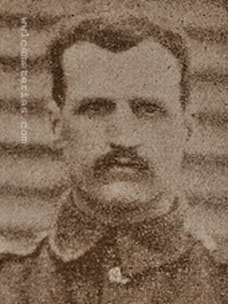
32629 Corporal
John William Jackson
7th Bn. King's Own, (Royal Lancaster Regiment)
15th June 1917, aged 32.
Plot XIV. F. 16.
Son of John William and Ann Jackson, of Burnley, Lancs; husband of Evelyn Brooks (formerly Jackson), of 191, Bury Rd., Rawtenstall, Manchester.
John Jackson was a reservist who was called up at the beginning of the war. Previously having served fourteen years with the forces, spending time in Gibraltar with the King's Royal Rifles.
Originally from Wakefield, his mother resided in Coal-Clough Lane, Burnley and John and his wife Evelyn lived at 10 Waterloo Road in the Burnley Wood area of the town. Prior to enlisting he was a firebeater at Folds' Rishton Mill, Gunsmith Lane, Burnley. He was the father of four children, one of whom had been born since the start of the war.
John William Jackson
7th Bn. King's Own, (Royal Lancaster Regiment)
15th June 1917, aged 32.
Plot XIV. F. 16.
Son of John William and Ann Jackson, of Burnley, Lancs; husband of Evelyn Brooks (formerly Jackson), of 191, Bury Rd., Rawtenstall, Manchester.
John Jackson was a reservist who was called up at the beginning of the war. Previously having served fourteen years with the forces, spending time in Gibraltar with the King's Royal Rifles.
Originally from Wakefield, his mother resided in Coal-Clough Lane, Burnley and John and his wife Evelyn lived at 10 Waterloo Road in the Burnley Wood area of the town. Prior to enlisting he was a firebeater at Folds' Rishton Mill, Gunsmith Lane, Burnley. He was the father of four children, one of whom had been born since the start of the war.
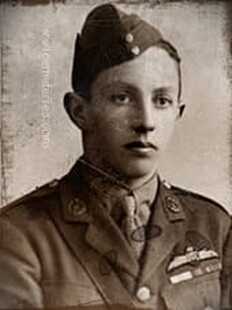
Second Lieutenant
Harold Jameson, M. C., D. C. M.
42nd Sqdn. Royal Flying Corps
5th January 1917, aged 20.
Plot IX. B. 16.
Medaille Militaire (France). Son of William Storm Jameson and Hannah Margaret Jameson, of "Ryedale," Chubb Hill, Whitby, Yorks. Served in France and Flanders from 10th Aug., 1914.
Harold Jameson, M. C., D. C. M.
42nd Sqdn. Royal Flying Corps
5th January 1917, aged 20.
Plot IX. B. 16.
Medaille Militaire (France). Son of William Storm Jameson and Hannah Margaret Jameson, of "Ryedale," Chubb Hill, Whitby, Yorks. Served in France and Flanders from 10th Aug., 1914.
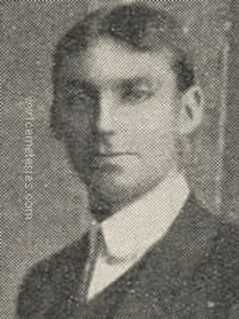
1420 Sapper
Alfred William Jarman
1st Coy. Australian Tunnelling Corps
13th June 1917, aged 35.
Plot XV. H. 19.
Originally of the No 1 Mining Corps (later 1 Australian Tunnelling Company) of Parramatta, NSW. A shipwright prior to enlisting, he embarked from Sydney aboard the HMAT Ulysses (A38) on 20 February 1916. He died on 13 June 1917, at the 2nd Canadian Clearing Station, France, of wounds received in action, aged 35.
Alfred William Jarman
1st Coy. Australian Tunnelling Corps
13th June 1917, aged 35.
Plot XV. H. 19.
Originally of the No 1 Mining Corps (later 1 Australian Tunnelling Company) of Parramatta, NSW. A shipwright prior to enlisting, he embarked from Sydney aboard the HMAT Ulysses (A38) on 20 February 1916. He died on 13 June 1917, at the 2nd Canadian Clearing Station, France, of wounds received in action, aged 35.
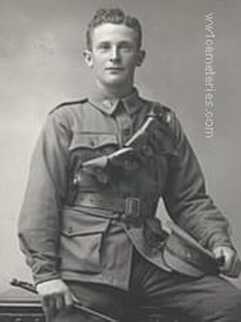
4524 Driver
Alfred Lawrence Jessop
1st Bde. Australian Field Artillery
22nd October 1917, aged 27.
Plot XXV. F. 20.
Son of Richard Nixon Jessop and Elizabeth Jessop, of 70, Margaret St., Launceston, Tasmania. Native of Victoria, Australia.
A painter prior to his enlistment on 16 March 1915 he embarked from Melbourne on board HMAT Wandilla on 18 June 1915.
Alfred Lawrence Jessop
1st Bde. Australian Field Artillery
22nd October 1917, aged 27.
Plot XXV. F. 20.
Son of Richard Nixon Jessop and Elizabeth Jessop, of 70, Margaret St., Launceston, Tasmania. Native of Victoria, Australia.
A painter prior to his enlistment on 16 March 1915 he embarked from Melbourne on board HMAT Wandilla on 18 June 1915.
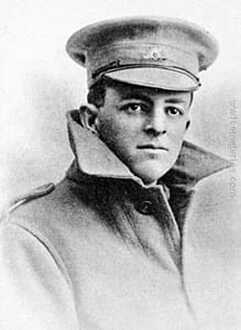
317 Private
Clarence William Johnson
21st Coy. Australian Machine Gun Corps
22nd September 1917, aged 23.
Plot XXIV. H. 9.
Son of Walter Murray Johnson and Christina Johnson, of Corowa, New South Wales.
A bank clerk prior to enlisting, he embarked from Melbourne aboard HMAT Commonwealth (A73) on 19 September 1916. On 21 September 1917, aged 23, he was wounded in action close to the Menin Road at Ypres, Belgium. He was hit by a shell burst whilst in the gun-pit re-filling belts and riddled by shrapnel. He died of his wounds on 22 September 1917, in the 3rd Canadian Casualty Clearing Station, Belgium.
Clarence William Johnson
21st Coy. Australian Machine Gun Corps
22nd September 1917, aged 23.
Plot XXIV. H. 9.
Son of Walter Murray Johnson and Christina Johnson, of Corowa, New South Wales.
A bank clerk prior to enlisting, he embarked from Melbourne aboard HMAT Commonwealth (A73) on 19 September 1916. On 21 September 1917, aged 23, he was wounded in action close to the Menin Road at Ypres, Belgium. He was hit by a shell burst whilst in the gun-pit re-filling belts and riddled by shrapnel. He died of his wounds on 22 September 1917, in the 3rd Canadian Casualty Clearing Station, Belgium.
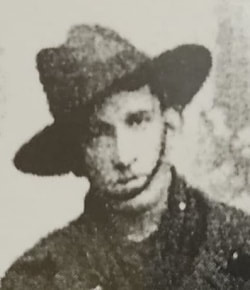
1550 Private
Harry Leonard Johnson
1st Reinforcements, 21st Bn. Australian Infantry, A. I. F.
25th September 1917.
Plot XXIII. C. 2.
Son of John Henry Johnson and Rose Agatha Johnson of Nagambie Victoria Australia.
A labourer on the family orchard in Nagambie, joined the 21st Battalion on 10th April 1915. He embarked on HMAT Berrima in Melbourne for Alexandria. On the way to Gallipoli aboard the troop ship Southland, the vessel was torpedoed by the German submarine UB14. Despite significant damage, the ship made it under its own steam to Mudros in the island of Lemnos. He proceeded to join the Military Expeditionary Force at Gallipoli on the 28th August 1915. Later he saw action in France and Belgium. It was in Belgium in one of the battles of Ypres that Harry died from wounds received in action on 23rd September 1917 after being taken to the 10th Casualty Clearing Station, Belgium.
Picture courtesy of Andrew Johnson (Great Nephew)
Harry Leonard Johnson
1st Reinforcements, 21st Bn. Australian Infantry, A. I. F.
25th September 1917.
Plot XXIII. C. 2.
Son of John Henry Johnson and Rose Agatha Johnson of Nagambie Victoria Australia.
A labourer on the family orchard in Nagambie, joined the 21st Battalion on 10th April 1915. He embarked on HMAT Berrima in Melbourne for Alexandria. On the way to Gallipoli aboard the troop ship Southland, the vessel was torpedoed by the German submarine UB14. Despite significant damage, the ship made it under its own steam to Mudros in the island of Lemnos. He proceeded to join the Military Expeditionary Force at Gallipoli on the 28th August 1915. Later he saw action in France and Belgium. It was in Belgium in one of the battles of Ypres that Harry died from wounds received in action on 23rd September 1917 after being taken to the 10th Casualty Clearing Station, Belgium.
Picture courtesy of Andrew Johnson (Great Nephew)
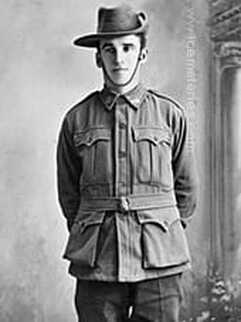
1725 Private
James Edward Johnson
59th Bn. Australian Infantry, A. I. F.
27th September 1917, aged 29.
Plot XXIV. G. 8A.
Son of Joseph and B. Johnson, of Neerim Junction, Victoria, Australia.
A labourer of Neerim Junction, Victoria prior to enlistment, he embarked with the 2nd Reinforcements on HMAT Euripides on 4 April 1916; he later transferred to the 59th Battalion. After being wounded at Polygon Wood, Belgium.
James Edward Johnson
59th Bn. Australian Infantry, A. I. F.
27th September 1917, aged 29.
Plot XXIV. G. 8A.
Son of Joseph and B. Johnson, of Neerim Junction, Victoria, Australia.
A labourer of Neerim Junction, Victoria prior to enlistment, he embarked with the 2nd Reinforcements on HMAT Euripides on 4 April 1916; he later transferred to the 59th Battalion. After being wounded at Polygon Wood, Belgium.
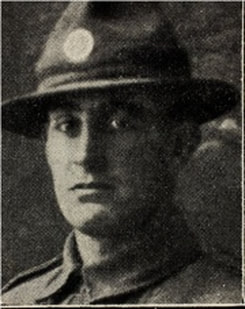
2/3063 Lance Corporal
Robert Haldane Johnston
1st Bn. Auckland Regiment, N. Z. E. F.
5th October 1917, aged 38.
Plot XXV. C. 12A.
Brother of Lewis John Johnston, of 1507, Pennsylvania Avenue, S.E. Washington, D.C., U.S.A. Native of Lawrence, Dunedin, New Zealand.
Picture courtesy of Rick Johnston.
Robert Haldane Johnston
1st Bn. Auckland Regiment, N. Z. E. F.
5th October 1917, aged 38.
Plot XXV. C. 12A.
Brother of Lewis John Johnston, of 1507, Pennsylvania Avenue, S.E. Washington, D.C., U.S.A. Native of Lawrence, Dunedin, New Zealand.
Picture courtesy of Rick Johnston.
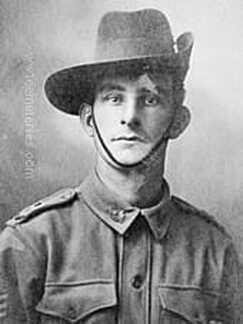
1153 Sergeant
Edward (Ted) Alexander Keid
9th Bn. Australian Infantry, A. I. F.
2nd November 1917
Plot XXI. FF. 6A.
Son of Charles George and Mary Elizabeth Keid, of Malonga Terrace, Graceville, Brisbane, Queensland. Native of Brisbane.
Sgt Keid, a farmer in civilian life, enlisted on 5 October 1914 along with his brother 1154 Private (Pte) Henry Charles Keid, both serving with the 9th Battalion. Sgt Keid died on 2 November 1917 from wounds received at the battle of Passchendaele. He was one of six brothers who enlisted, four of whom were killed in action and one was wounded.
Edward (Ted) Alexander Keid
9th Bn. Australian Infantry, A. I. F.
2nd November 1917
Plot XXI. FF. 6A.
Son of Charles George and Mary Elizabeth Keid, of Malonga Terrace, Graceville, Brisbane, Queensland. Native of Brisbane.
Sgt Keid, a farmer in civilian life, enlisted on 5 October 1914 along with his brother 1154 Private (Pte) Henry Charles Keid, both serving with the 9th Battalion. Sgt Keid died on 2 November 1917 from wounds received at the battle of Passchendaele. He was one of six brothers who enlisted, four of whom were killed in action and one was wounded.
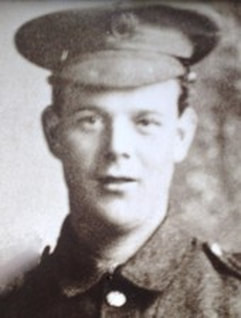
266 Rifleman
Hugh Kelly
13th Bn. Royal Irish Rifles
16th August 1917, aged 28.
XVII. AA. 14.
Husband of Sarah Kelly, of Bridge St., Comber, Co. Down.
In memory of Hugh Kelly who went to war never to return, leaving behind his wife and children. This photo belonged to his daughter Mary Foster.
Courtesy of Martin Neal
Hugh Kelly
13th Bn. Royal Irish Rifles
16th August 1917, aged 28.
XVII. AA. 14.
Husband of Sarah Kelly, of Bridge St., Comber, Co. Down.
In memory of Hugh Kelly who went to war never to return, leaving behind his wife and children. This photo belonged to his daughter Mary Foster.
Courtesy of Martin Neal
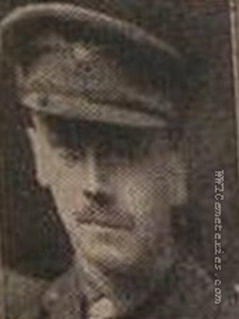
Lieutenant-Colonel
Henry Herbert Kemble, D. S. O,. M. C.
Cdg. 23rd Bn. London Regiment
7th June 1917, aged 40.
Plot X. A. 46.
Son of William Kemble, (I.C.S.), and Elizabeth Emma Kemble. Born at Purneah, India.
Henry Herbert Kemble, D. S. O,. M. C.
Cdg. 23rd Bn. London Regiment
7th June 1917, aged 40.
Plot X. A. 46.
Son of William Kemble, (I.C.S.), and Elizabeth Emma Kemble. Born at Purneah, India.
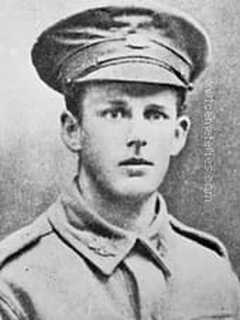
3538 Driver
Phillip Sydney King Kemp
101st Howitzer Bty. Australian Field Artillery
18th October 1917
Plot XXI. E. 18.
Son of Richard Edgar and Honoria Elizabeth Kemp; husband of Gertrude L. King Kemp, of "Malua," Park Rd., Burwood, New South Wales.
An insurance inspector prior to enlisting on 10 May 1915, he embarked from Sydney aboard HMAT Beltana on 9 November 1915. Dvr Kemp was given the service number 3538 when he transferred to the 101st Howitzer Battery, Australian Field Artillery. He was wounded in action - gassed - at Passchendaele, Belgium, and died on 18 October 1917. His brother, 19104 Gunner Wilfred Foxton King Kemp, 28th Battery, 7th Field Artillery Brigade, died on 29 May 1917, in France, aged 28 years and is buried at the St. Sever Cemetery Extension. He was a descendant of Phillip Gidley King, Third Governor of NSW, one of over 50 whom served in the First World War.
Phillip Sydney King Kemp
101st Howitzer Bty. Australian Field Artillery
18th October 1917
Plot XXI. E. 18.
Son of Richard Edgar and Honoria Elizabeth Kemp; husband of Gertrude L. King Kemp, of "Malua," Park Rd., Burwood, New South Wales.
An insurance inspector prior to enlisting on 10 May 1915, he embarked from Sydney aboard HMAT Beltana on 9 November 1915. Dvr Kemp was given the service number 3538 when he transferred to the 101st Howitzer Battery, Australian Field Artillery. He was wounded in action - gassed - at Passchendaele, Belgium, and died on 18 October 1917. His brother, 19104 Gunner Wilfred Foxton King Kemp, 28th Battery, 7th Field Artillery Brigade, died on 29 May 1917, in France, aged 28 years and is buried at the St. Sever Cemetery Extension. He was a descendant of Phillip Gidley King, Third Governor of NSW, one of over 50 whom served in the First World War.
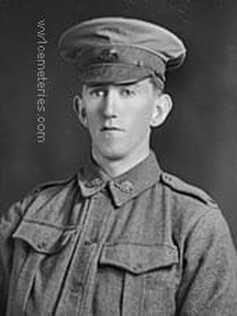
Second Lieutenant
Edward Joseph Kernan
5th Bn. Australian Infantry, A. I. F.
20th September 1917
Plot XXIII. B. 8.
He enlisted in July 1915 and spent time as a musketry instructor before eventually embarking with the 24th Reinforcements and the rank of 2nd Lieutenant (2nd Lt) on HMAT Ballarat, departing Melbourne on 19 February 1917. He died of wounds on 20 September 1917, aged 25 years. He, along with all others aboard, survived the sinking of the Ballarat when it was torpedoed in the English Channel on 25 April 1917.
Edward Kernan was first of all taken to the Menin Road Dressing Station before being tranferred and admitted to the No.10 C. C. S. at Poperinghe on 20th September 1917, suffering from a shell wound to the abdomen. Hospital records show that he died on 21st September 1917. C. W. G. C. records show his date of death as 20th September.
Edward Joseph Kernan
5th Bn. Australian Infantry, A. I. F.
20th September 1917
Plot XXIII. B. 8.
He enlisted in July 1915 and spent time as a musketry instructor before eventually embarking with the 24th Reinforcements and the rank of 2nd Lieutenant (2nd Lt) on HMAT Ballarat, departing Melbourne on 19 February 1917. He died of wounds on 20 September 1917, aged 25 years. He, along with all others aboard, survived the sinking of the Ballarat when it was torpedoed in the English Channel on 25 April 1917.
Edward Kernan was first of all taken to the Menin Road Dressing Station before being tranferred and admitted to the No.10 C. C. S. at Poperinghe on 20th September 1917, suffering from a shell wound to the abdomen. Hospital records show that he died on 21st September 1917. C. W. G. C. records show his date of death as 20th September.
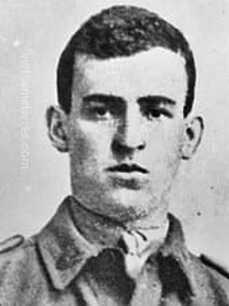
2396A Sergeant
Vernon Gordon King
11th Bde. Australian Field Artillery
22nd October 1917
Plot XXII. B. 19.
Son of Baron Albert and Annie Seymour King, of 37, Denmark St., Kew, Victoria, Australia.
A clerk prior to enlisting on 8 March 1915, he embarked from Melbourne aboard HMAT Euripides on 10 May 1915, with service number 1052, as a member of A Company, 24th Battalion. King was transferred to the Heavy Battery Divisional Artillery on 17 September 1915 and was promoted to sergeant on 30 June 1916. Sgt King was wounded at Anzac Ridge, Passchendaele, Belgium, and died on 22 October 1917, aged 20 years. He was a descendant of Phillip Gidley King, Third Governor of NSW, one of over 50 whom served in the First World War.
Vernon Gordon King
11th Bde. Australian Field Artillery
22nd October 1917
Plot XXII. B. 19.
Son of Baron Albert and Annie Seymour King, of 37, Denmark St., Kew, Victoria, Australia.
A clerk prior to enlisting on 8 March 1915, he embarked from Melbourne aboard HMAT Euripides on 10 May 1915, with service number 1052, as a member of A Company, 24th Battalion. King was transferred to the Heavy Battery Divisional Artillery on 17 September 1915 and was promoted to sergeant on 30 June 1916. Sgt King was wounded at Anzac Ridge, Passchendaele, Belgium, and died on 22 October 1917, aged 20 years. He was a descendant of Phillip Gidley King, Third Governor of NSW, one of over 50 whom served in the First World War.
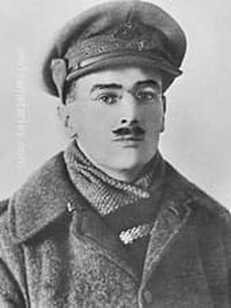
572 Sergeant
William Angus Kirkland
5th Bn. Australian Infantry, A. I. F.
20th September 1917
Plot XXIII. D. 12A.
Son of William and Margaret Kirkland, of "Willangus," 19, Murray St., Elsternwick, Victoria, Australia. Native of Ballarat, Victoria.
A 20 year old accountant prior to enlistment on 17 August 1914, he embarked for overseas as a Private with F Company from Melbourne on 21 October 1914 aboard HMAT Orvieto. While serving at Gallipoli, he was wounded in action in May 1915 and evacuated for medical treatment. After returning to his battalion at Gallipoli in July, he was promoted to Lance Corporal on 4 September 1915 and then he took ill later that month and was eventually evacuated to the UK. He rejoined the 5th Battalion in France in July 1916 and was promoted to Corporal on 4 August 1916. After being wounded in action in France on 4 November 1916 he was evacuated to the UK and did not rejoin his battalion until 21 June 1917. He was promoted to Sergeant on 11 September 1917 and then wounded in action again on 20 September 1917 near the Menin Road, Belgium. He succumbed to these wounds on the same day.
William Angus Kirkland
5th Bn. Australian Infantry, A. I. F.
20th September 1917
Plot XXIII. D. 12A.
Son of William and Margaret Kirkland, of "Willangus," 19, Murray St., Elsternwick, Victoria, Australia. Native of Ballarat, Victoria.
A 20 year old accountant prior to enlistment on 17 August 1914, he embarked for overseas as a Private with F Company from Melbourne on 21 October 1914 aboard HMAT Orvieto. While serving at Gallipoli, he was wounded in action in May 1915 and evacuated for medical treatment. After returning to his battalion at Gallipoli in July, he was promoted to Lance Corporal on 4 September 1915 and then he took ill later that month and was eventually evacuated to the UK. He rejoined the 5th Battalion in France in July 1916 and was promoted to Corporal on 4 August 1916. After being wounded in action in France on 4 November 1916 he was evacuated to the UK and did not rejoin his battalion until 21 June 1917. He was promoted to Sergeant on 11 September 1917 and then wounded in action again on 20 September 1917 near the Menin Road, Belgium. He succumbed to these wounds on the same day.
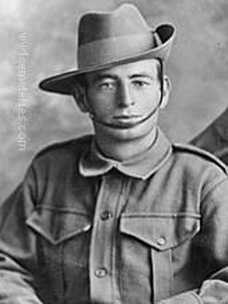
4921 Lance Corporal
George Kirvan, M. M.
50th Bn. Australian Infantry, A. I. F.
28th October 1917, aged 26.
Plot XXI. G. 21.
From Port Adelaide, South Australia. A 25 year old shearer prior to enlisting on 11 January 1916, he embarked for overseas with the 15th Reinforcements of the 10th Battalion from Adelaide on 9 March 1916 aboard RMS Mongolia. After transiting through Egypt, he arrived in France in May and transferred to the 50th Battalion in August 1916. Following promotion to Lance Corporal (L Cpl) in May, he was awarded a Military Medal in June 1917. L Cpl Kirvan was wounded in action at Broodseinde Ridge, Belgium on 18 October and died from his wounds on 28 October 1917.
George Kirvan, M. M.
50th Bn. Australian Infantry, A. I. F.
28th October 1917, aged 26.
Plot XXI. G. 21.
From Port Adelaide, South Australia. A 25 year old shearer prior to enlisting on 11 January 1916, he embarked for overseas with the 15th Reinforcements of the 10th Battalion from Adelaide on 9 March 1916 aboard RMS Mongolia. After transiting through Egypt, he arrived in France in May and transferred to the 50th Battalion in August 1916. Following promotion to Lance Corporal (L Cpl) in May, he was awarded a Military Medal in June 1917. L Cpl Kirvan was wounded in action at Broodseinde Ridge, Belgium on 18 October and died from his wounds on 28 October 1917.
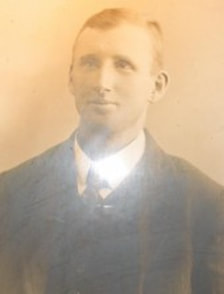
3378 Private
William Robert Knox
6th Bn. Australian Infantry, A. I. F.
22nd September 1917, aged 32.
Plot XXIV. F. 3.
Born: Dookie, Victoria. August 20th, 1885 Son of Robert and Mary Jane Knox. Enlisted July 13 1915. Embarked 11 October 1915 at Adelaide on HMAT Nestor. 6th Battalion AIF No. 3378.
Died : September 22 1917 from wounds received on September 20 1917. His Company was in action at Glencorse Wood during the early stages of the Battle for Polygon Wood.
William Robert Knox
6th Bn. Australian Infantry, A. I. F.
22nd September 1917, aged 32.
Plot XXIV. F. 3.
Born: Dookie, Victoria. August 20th, 1885 Son of Robert and Mary Jane Knox. Enlisted July 13 1915. Embarked 11 October 1915 at Adelaide on HMAT Nestor. 6th Battalion AIF No. 3378.
Died : September 22 1917 from wounds received on September 20 1917. His Company was in action at Glencorse Wood during the early stages of the Battle for Polygon Wood.
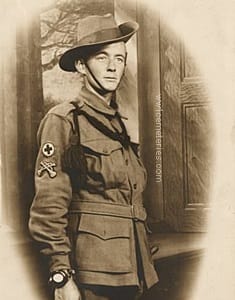
1068 Lance Corporal
Clifford Labram, M. M.
50th Bn. Australian Infantry, A. I. F.
14th October 1917, aged 22.
Plot XXI. C. 1.
Son of Thomas and Mary Jane Labram, of 15, Winwood St., Southwark, Adelaide, South Australia.
From Southwark, South Australia. A 21 year old labourer prior to enlisting on 11 September 1914, he embarked for overseas with B Section, 4th Field Ambulance, 4th Infantry Brigade from Melbourne on 22 December 1914 aboard HMAT Berrima. After serving at Gallipoli, he went to France in June 1916 with the 4th Field Ambulance but after less than two weeks was taken ill and evacuated to England for medical treatment. After returning to France, he transferred to the 50th Battalion on 6 March 1917 and was wounded in action on 2 April 1917. Two months later he returned to the 50th Battalion and was promoted to Lance Corporal (L Cpl) on 6 July 1917. He was awarded a Military Medal for bravery in treating and rescuing wounded soldiers at Zonnebeke, Belgium on 26 September 1917. L Cpl Labram was wounded in action on 13 October 1917 and died from his wounds the next day.
Clifford Labram, M. M.
50th Bn. Australian Infantry, A. I. F.
14th October 1917, aged 22.
Plot XXI. C. 1.
Son of Thomas and Mary Jane Labram, of 15, Winwood St., Southwark, Adelaide, South Australia.
From Southwark, South Australia. A 21 year old labourer prior to enlisting on 11 September 1914, he embarked for overseas with B Section, 4th Field Ambulance, 4th Infantry Brigade from Melbourne on 22 December 1914 aboard HMAT Berrima. After serving at Gallipoli, he went to France in June 1916 with the 4th Field Ambulance but after less than two weeks was taken ill and evacuated to England for medical treatment. After returning to France, he transferred to the 50th Battalion on 6 March 1917 and was wounded in action on 2 April 1917. Two months later he returned to the 50th Battalion and was promoted to Lance Corporal (L Cpl) on 6 July 1917. He was awarded a Military Medal for bravery in treating and rescuing wounded soldiers at Zonnebeke, Belgium on 26 September 1917. L Cpl Labram was wounded in action on 13 October 1917 and died from his wounds the next day.
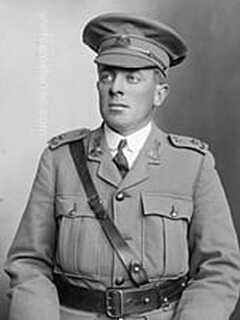
Lieutenant
Stephen Lade, Mentioned in Despatches
13th Australian Light Horse
25th September 1917, aged 33.
Plot XXIII. A. 1.
Son of Henry Vincent and Mary Ann Lade, of Broadford, Victoria, Australia.
2nd Lt Lade enlisted on 16 July 1915 and embarked from Melbourne aboard HMAT Hororata on 27 September 1915. He was promoted to Lieutenant on 23 July 1916 and died of wounds on 25 September 1917 in Belgium.
Lieutenant Lade and his men were hit by a shell close to Zillebeke whilst visiting Machine Gun positions, he was severely wounded by the blast and one leg was blown off in the explosion. He was taken to a Dressing Station and later moved to the Canadian Hospital at Poperinghe where he died , his last words, as he was taken away by stretcher bearers were said to have been "Carry on Boys."
Stephen Lade, Mentioned in Despatches
13th Australian Light Horse
25th September 1917, aged 33.
Plot XXIII. A. 1.
Son of Henry Vincent and Mary Ann Lade, of Broadford, Victoria, Australia.
2nd Lt Lade enlisted on 16 July 1915 and embarked from Melbourne aboard HMAT Hororata on 27 September 1915. He was promoted to Lieutenant on 23 July 1916 and died of wounds on 25 September 1917 in Belgium.
Lieutenant Lade and his men were hit by a shell close to Zillebeke whilst visiting Machine Gun positions, he was severely wounded by the blast and one leg was blown off in the explosion. He was taken to a Dressing Station and later moved to the Canadian Hospital at Poperinghe where he died , his last words, as he was taken away by stretcher bearers were said to have been "Carry on Boys."
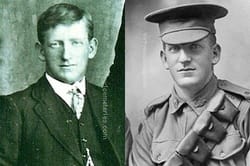
3867 Gunner
Andrew Richard Larkin
1st Bde. Australian Field Artillery
22nd July 1917, aged 25.
Plot XVI. C. 4.
Son of Michael and Catherine Ann Larkin, of Tarwin Meadows, Gippsland, Victoria, Australia. Native of Victoria.
From Casterton Vic, who enlisted on 30 November 1914 and died of wounds on 22 July 1917, aged 25 years. He was one of four brothers who served in the AIF. Another brother Private Michael Edward Larkin of the 8th Light Horse was killed in action on 7 August 1915, and is commemorated on the Lone Pine Memorial.
Andrew Richard Larkin
1st Bde. Australian Field Artillery
22nd July 1917, aged 25.
Plot XVI. C. 4.
Son of Michael and Catherine Ann Larkin, of Tarwin Meadows, Gippsland, Victoria, Australia. Native of Victoria.
From Casterton Vic, who enlisted on 30 November 1914 and died of wounds on 22 July 1917, aged 25 years. He was one of four brothers who served in the AIF. Another brother Private Michael Edward Larkin of the 8th Light Horse was killed in action on 7 August 1915, and is commemorated on the Lone Pine Memorial.
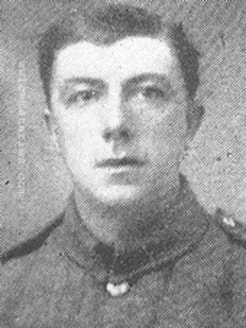
242873 Private
Harry Laycock
2nd/6th Bn. Lancashire Fusiliers
11th October 1917, aged 33.
Plot XX. J. 11A.
Husband of Beatrice Laycock, of 30, Gorple St., Harle Syke, Burnley.
Harry enlisted in June 1916 after being rejected three times on account of his height, he was only 5ft 1". He went overseas in February 1917. He left a widow and two children.
Prior to enlisting he worked as a weaver at the Haggate Weaving Co's. Mill. He was an outstanding Billiards player and was always in demand for "socials and entertainments" in the district due to his ability as a comic singer. He was described as "A very cheerful young fellow, fond of larks, and well liked."
The army Chaplain, in a letter to his wife, expressed deep sympathy and spoke of the loyal and faithful devotion with which he served.
Harry Laycock
2nd/6th Bn. Lancashire Fusiliers
11th October 1917, aged 33.
Plot XX. J. 11A.
Husband of Beatrice Laycock, of 30, Gorple St., Harle Syke, Burnley.
Harry enlisted in June 1916 after being rejected three times on account of his height, he was only 5ft 1". He went overseas in February 1917. He left a widow and two children.
Prior to enlisting he worked as a weaver at the Haggate Weaving Co's. Mill. He was an outstanding Billiards player and was always in demand for "socials and entertainments" in the district due to his ability as a comic singer. He was described as "A very cheerful young fellow, fond of larks, and well liked."
The army Chaplain, in a letter to his wife, expressed deep sympathy and spoke of the loyal and faithful devotion with which he served.
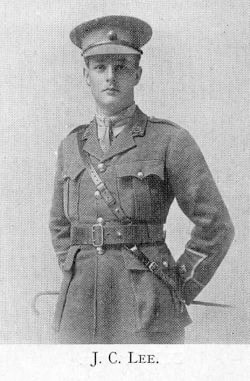
Second Lieutenant
James Clifford Lee
2nd Bn. Royal Berkshire Regiment
1st August 1917, aged 19.
Plot XIV. A. 14.
Son of Howard W. and Maud Mary Lee, of Spring Vale, Foxlydiate, nr. Redditch. Entered Sandhurst Aug., 1915. Gazetted to the Royal Berkshires March, 1916, at the age of 18.
His headstone bears the inscription "Faithful Unto Death Dulce Et Decorum Est Pro Patria Mori"
The information below supplied by 'The Ellesmerian Club', the alumni organisation for Ellesmere College where James was a pupil.
James Clifford Lee
2nd Bn. Royal Berkshire Regiment
1st August 1917, aged 19.
Plot XIV. A. 14.
Son of Howard W. and Maud Mary Lee, of Spring Vale, Foxlydiate, nr. Redditch. Entered Sandhurst Aug., 1915. Gazetted to the Royal Berkshires March, 1916, at the age of 18.
His headstone bears the inscription "Faithful Unto Death Dulce Et Decorum Est Pro Patria Mori"
The information below supplied by 'The Ellesmerian Club', the alumni organisation for Ellesmere College where James was a pupil.
James Clifford Lee, the younger son of Howard and Henrietta Lee, was born in Redditch on 23rd March 1898. His father was a needle and fishing hook manufacturer and at the time the family were resident at Spring Vale House, Web Heath, Bromsgrove
James entered the ‘Conqueror’ dormitory at Ellesmere College on 19th June 1909 when he was just eleven years old and there were only one hundred and forty-one pupils on the nominal roll. His elder brother, Dudley, was Captain of School but left at the end of July. During his time at the college James took a very active part in many sports from rugby, hockey (where he gained his Colours), football (he ended up being captain of his dormitory team), cricket (attaining his 1st XI Colours) and athletics where he seemed to be a fine runner.
Away from the sports field he took part in many other activities – he was an active member of the Debating Society and enjoyed drama. He was in the Officer Training Corps, was promoted Sergeant and was a member of the ‘Shooting VIII’. He sat his Preliminary Oxford Local Exams in 1911 and was appointed a dormitory Prefect. He stayed for five years, leaving in December 1913, to join his uncle in the Bermudas.
At the outbreak of war, he determined to return to England and left New York on the ‘Lusitania’, arriving back in the country on 29th September 1914.
He passed into the Royal Military College, Sandhurst in August 1915 and while there became Under-Officer of ‘F’ Company. He was gazetted as a 2nd Lieutenant to the 2nd Battalion, the Royal Berkshire Regiment in March 1916 when just eighteen years old. He then undertook a further year of training at various places in England and was to be found in Portsmouth in August that year. A report in the Reading Mercury on a cricket match between the Officers and Sergeants of the 3rd Battalion, the Berkshire Regiment at the Clarence Ground, Portsmouth showed he scored 5 runs before being bowled out. Some seven months later, on April 5th 1917, he embarked for France and Flanders with the British Expeditionary Force.
Whilst in France he was appointed Signal Officer of his battalion and, just before his death, he wrote that he was temporarily on the Brigade Staff and was doing important work.
He was seriously wounded by an exploding shell outside Brigade Headquarters at Ypres on July 31st 1917 and died in the No. 14 Casualty Clearing Station the following day. He was awarded the Victory Medal and the British War Medal.
His obituary appeared in The Ellesmerian with a frontispiece photograph in the same edition:
“Clifford Lee possessed a cheerfulness that made him ever popular in the School; but with all his gaiety and geniality there was an amount of earnestness and efficiency. He was a prefect for only a short time but had he remained at school he would have undoubtedly have followed in his brother’s footsteps and been raised to the responsible position of Captain of School”.
His Commanding Officer wrote:
”…..I have been closely associated with your son for nearly two months and know him to be fearless and ever strongly devoted to duty. He was a most promising officer and extremely popular with his brother officers and also with the regimental signallers of whom he was in command. His Brigade Signal Detachment which he had been specially chosen to command ask me to include their deepest sympathies”.
A brother officer wrote “
“Those who knew him loved him for his purity of character, and his entire devotion to what he chose as his life’s work. His was truly a dedicated life.”
He was buried at Lijssenthoek Military Cemetery, Poperinghe. His sacrifice is also recorded on memorials at St. Batholomew’s Church, Tardebigge; St. Philips Church, Webheath and the Memorial at Ellesmere College.
James entered the ‘Conqueror’ dormitory at Ellesmere College on 19th June 1909 when he was just eleven years old and there were only one hundred and forty-one pupils on the nominal roll. His elder brother, Dudley, was Captain of School but left at the end of July. During his time at the college James took a very active part in many sports from rugby, hockey (where he gained his Colours), football (he ended up being captain of his dormitory team), cricket (attaining his 1st XI Colours) and athletics where he seemed to be a fine runner.
Away from the sports field he took part in many other activities – he was an active member of the Debating Society and enjoyed drama. He was in the Officer Training Corps, was promoted Sergeant and was a member of the ‘Shooting VIII’. He sat his Preliminary Oxford Local Exams in 1911 and was appointed a dormitory Prefect. He stayed for five years, leaving in December 1913, to join his uncle in the Bermudas.
At the outbreak of war, he determined to return to England and left New York on the ‘Lusitania’, arriving back in the country on 29th September 1914.
He passed into the Royal Military College, Sandhurst in August 1915 and while there became Under-Officer of ‘F’ Company. He was gazetted as a 2nd Lieutenant to the 2nd Battalion, the Royal Berkshire Regiment in March 1916 when just eighteen years old. He then undertook a further year of training at various places in England and was to be found in Portsmouth in August that year. A report in the Reading Mercury on a cricket match between the Officers and Sergeants of the 3rd Battalion, the Berkshire Regiment at the Clarence Ground, Portsmouth showed he scored 5 runs before being bowled out. Some seven months later, on April 5th 1917, he embarked for France and Flanders with the British Expeditionary Force.
Whilst in France he was appointed Signal Officer of his battalion and, just before his death, he wrote that he was temporarily on the Brigade Staff and was doing important work.
He was seriously wounded by an exploding shell outside Brigade Headquarters at Ypres on July 31st 1917 and died in the No. 14 Casualty Clearing Station the following day. He was awarded the Victory Medal and the British War Medal.
His obituary appeared in The Ellesmerian with a frontispiece photograph in the same edition:
“Clifford Lee possessed a cheerfulness that made him ever popular in the School; but with all his gaiety and geniality there was an amount of earnestness and efficiency. He was a prefect for only a short time but had he remained at school he would have undoubtedly have followed in his brother’s footsteps and been raised to the responsible position of Captain of School”.
His Commanding Officer wrote:
”…..I have been closely associated with your son for nearly two months and know him to be fearless and ever strongly devoted to duty. He was a most promising officer and extremely popular with his brother officers and also with the regimental signallers of whom he was in command. His Brigade Signal Detachment which he had been specially chosen to command ask me to include their deepest sympathies”.
A brother officer wrote “
“Those who knew him loved him for his purity of character, and his entire devotion to what he chose as his life’s work. His was truly a dedicated life.”
He was buried at Lijssenthoek Military Cemetery, Poperinghe. His sacrifice is also recorded on memorials at St. Batholomew’s Church, Tardebigge; St. Philips Church, Webheath and the Memorial at Ellesmere College.
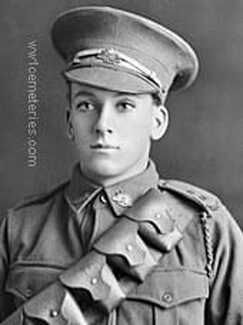
19993 Gunner
Albert Arthur Le Roux
8th Bde. Australian Field Artillery
27th September 1917, aged 20.
Plot XXIV. G. 2A.
Son of Prosper Henry Victor and Caroline Le Roux. Native of Lang Lang, Victoria, Australia.
An 18 year old clerk prior to enlisting on 4 February 1916, he embarked for overseas with the 31st Battery from Melbourne on 20 May 1916 aboard HMAT Medic. While serving on the Western Front, he died on 27 September 1917 of wounds received at the Battle of Passchendaele, Belgium. His older brother 5856 Lance Corporal Prosper Reginald Victor Le Roux, 24th Battalion enlisted four days after Albert and also lost his life at the Battle of Passchendaele on 4 October 1917. He is commemorated on the Menin Gate Memorial.
Albert Arthur Le Roux
8th Bde. Australian Field Artillery
27th September 1917, aged 20.
Plot XXIV. G. 2A.
Son of Prosper Henry Victor and Caroline Le Roux. Native of Lang Lang, Victoria, Australia.
An 18 year old clerk prior to enlisting on 4 February 1916, he embarked for overseas with the 31st Battery from Melbourne on 20 May 1916 aboard HMAT Medic. While serving on the Western Front, he died on 27 September 1917 of wounds received at the Battle of Passchendaele, Belgium. His older brother 5856 Lance Corporal Prosper Reginald Victor Le Roux, 24th Battalion enlisted four days after Albert and also lost his life at the Battle of Passchendaele on 4 October 1917. He is commemorated on the Menin Gate Memorial.
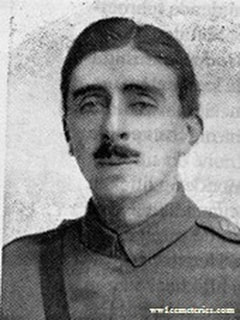
Major and Brevet Lieutenant Colonel
Donald Swain Lewis, D. S. O., M. I. D.
1st Sqdn. (2nd Wing) Royal Flying Corps and Royal Engineers
10th April 1916, aged 30.
Plot V. A. 25.
Son of Capt. Ernest and Maria Jane Lewis, of Guildford; husband of Margaret Maitland (formerly Lewis), of 72, Addison Rd., West Kensington, London.
Donald Swain Lewis, D. S. O., M. I. D.
1st Sqdn. (2nd Wing) Royal Flying Corps and Royal Engineers
10th April 1916, aged 30.
Plot V. A. 25.
Son of Capt. Ernest and Maria Jane Lewis, of Guildford; husband of Margaret Maitland (formerly Lewis), of 72, Addison Rd., West Kensington, London.
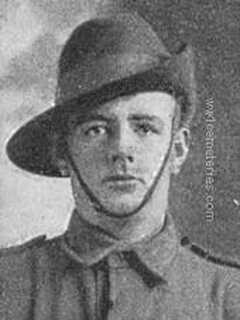
605 Private
Robert William Linklater
20th Bn. Australian Infantry, A. I. F.
3rd November 1917, aged 24.
Plot XXI. HH. 4A.
Son of the late John William and Mary Ann Linklater. Native of Sydney, New South Wales.
A labourer prior to enlisting in Hyde Park, NSW, on 8 March 1915, Pte Linklater embarked from Sydney, NSW, aboard HMAT Berrima on 25 June 1915. He died of wounds received at Passchendaele, Belgium, on 3 November 1917, aged 24.
Robert William Linklater
20th Bn. Australian Infantry, A. I. F.
3rd November 1917, aged 24.
Plot XXI. HH. 4A.
Son of the late John William and Mary Ann Linklater. Native of Sydney, New South Wales.
A labourer prior to enlisting in Hyde Park, NSW, on 8 March 1915, Pte Linklater embarked from Sydney, NSW, aboard HMAT Berrima on 25 June 1915. He died of wounds received at Passchendaele, Belgium, on 3 November 1917, aged 24.
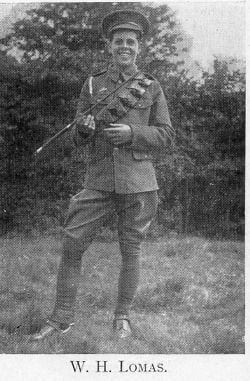
31592 Private
William Harrison Lomas
2nd Bn. South Lancashire Regiment
27th August 1917, aged 21.
Plot XVIII. G. 14.
Son of Percy and Mary Lomas, of Woodbine Cottage, Lower Peover, Cheshire. Joined the Earl of Chester's Imp. Yeomanry on 5th Oct., 1914. Born Manchester.
His headstone bears the inscription "Sits He With Those That Praise Our God For That They Served His World"
The information below supplied by 'The Ellesmerian Club', the alumni organisation for Ellesmere College where William was a pupil.
William Harrison Lomas
2nd Bn. South Lancashire Regiment
27th August 1917, aged 21.
Plot XVIII. G. 14.
Son of Percy and Mary Lomas, of Woodbine Cottage, Lower Peover, Cheshire. Joined the Earl of Chester's Imp. Yeomanry on 5th Oct., 1914. Born Manchester.
His headstone bears the inscription "Sits He With Those That Praise Our God For That They Served His World"
The information below supplied by 'The Ellesmerian Club', the alumni organisation for Ellesmere College where William was a pupil.
William Harrison Lomas, the only son of John Percy and Mary Lomas of Lower Peover, Cheshire was born on 31st January 1896 in Chorlton-cum-Hardy, Lancashire. His early education was at Wincham Hall after which he progressed to Sir John Deane’s Grammar School, Northwich arriving there on 17th September 1906. At the time the family lived at Woodbine Cottage, Plumbley, Cheshire.
He entered Ellesmere College in September 1910 and was allocated to the ‘Woodard’ dormitory and Form IV under the guidance of Mr. Moore. There were twenty seven new boys admitted that term – four of them would die serving their country in the war.
During the two years he spent at Ellesmere he may not have become heavily involved in a large range of activities but he represented his dormitory at football and had a role in the Shakespearian Society production of ‘Julius Caesar’ (1912) whilst preparing for his Oxford Local Exams.
He left the college in December 1912 and it is likely he joined his father in the calico trade. However, any chosen career was cut short as, less than two years after leaving Ellesmere, he enlisted.
The few remnants that have survived of his original Attestation Papers, which he signed on 6th October 1914 in Chester, reveal that he was posted to the Earl of Cheshire’s Imperial Yeomanry as Private Lomas, Service No. 1210, later changed to 31592.
At the end of September 1916, he was transferred to the 4th (Reserve) Battalion, the South Lancashire Regiment (Territorial Force) and then posted to the 2ndBattalion, the South Lancashire Regiment, who had seen action in the defence of Vimy Ridge in May that year. On the 21st of June 1916, they transferred to the 64th Brigade, the 21st Division and were in action in the Battles of The Somme, including the Battle of Morval in which the Division captured Geudecourt. In 1917, they were in action during the German retreat to the Hindenburg Line, the Arras offensive, the Third Battles of Ypres and the Cambrai Operations.
William was wounded on 21st October 1916 when fighting on the Somme and was gassed at Ypres the following June. He died from lobar pneumonia (brought on as a direct result of his gassing and subsequent exposure) on the 27th August 1917 at the 2nd Canadian Casualty Clearing Station, Popereinghe. He was buried at Lyssenthoek Cemetery.
He was awarded the Victory Medal and the British War Medal. His sacrifice is commemorated on various War Memorials including those at St. Oswald’s Church, Lower Peover Cheshire; the War Memorial at Bollington, Cheshire; the Cheshire Yeomanry Memorial at Chester Cathedral; the War Memorial at Knutsford and the Ellesmere College Memorial.
He entered Ellesmere College in September 1910 and was allocated to the ‘Woodard’ dormitory and Form IV under the guidance of Mr. Moore. There were twenty seven new boys admitted that term – four of them would die serving their country in the war.
During the two years he spent at Ellesmere he may not have become heavily involved in a large range of activities but he represented his dormitory at football and had a role in the Shakespearian Society production of ‘Julius Caesar’ (1912) whilst preparing for his Oxford Local Exams.
He left the college in December 1912 and it is likely he joined his father in the calico trade. However, any chosen career was cut short as, less than two years after leaving Ellesmere, he enlisted.
The few remnants that have survived of his original Attestation Papers, which he signed on 6th October 1914 in Chester, reveal that he was posted to the Earl of Cheshire’s Imperial Yeomanry as Private Lomas, Service No. 1210, later changed to 31592.
At the end of September 1916, he was transferred to the 4th (Reserve) Battalion, the South Lancashire Regiment (Territorial Force) and then posted to the 2ndBattalion, the South Lancashire Regiment, who had seen action in the defence of Vimy Ridge in May that year. On the 21st of June 1916, they transferred to the 64th Brigade, the 21st Division and were in action in the Battles of The Somme, including the Battle of Morval in which the Division captured Geudecourt. In 1917, they were in action during the German retreat to the Hindenburg Line, the Arras offensive, the Third Battles of Ypres and the Cambrai Operations.
William was wounded on 21st October 1916 when fighting on the Somme and was gassed at Ypres the following June. He died from lobar pneumonia (brought on as a direct result of his gassing and subsequent exposure) on the 27th August 1917 at the 2nd Canadian Casualty Clearing Station, Popereinghe. He was buried at Lyssenthoek Cemetery.
He was awarded the Victory Medal and the British War Medal. His sacrifice is commemorated on various War Memorials including those at St. Oswald’s Church, Lower Peover Cheshire; the War Memorial at Bollington, Cheshire; the Cheshire Yeomanry Memorial at Chester Cathedral; the War Memorial at Knutsford and the Ellesmere College Memorial.
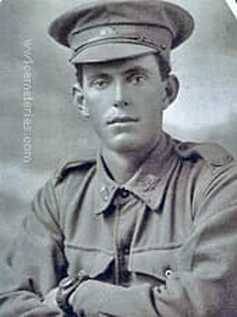
135 Sergeant
Walter John Longworth
35th Bn. Australian Infantry, A. I. F.
12th October 1917, aged 24.
Plot XXI. A. 4.
Son of Mr. and Mrs. R. Longworth, of Lauriston, North Coast, New South Wales.
A butcher prior enlistment he embarked with the A Company on HMAT Benella (A24) on 1 May 1916. Sgt Longworth died of wounds on 12 October 1917.
Walter John Longworth
35th Bn. Australian Infantry, A. I. F.
12th October 1917, aged 24.
Plot XXI. A. 4.
Son of Mr. and Mrs. R. Longworth, of Lauriston, North Coast, New South Wales.
A butcher prior enlistment he embarked with the A Company on HMAT Benella (A24) on 1 May 1916. Sgt Longworth died of wounds on 12 October 1917.
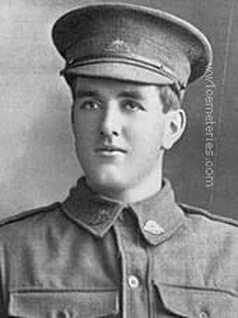
4080 Private
Robert MacDonald
46th Bn. Australian Infantry, A. I. F.
17th October 1917, aged 21,
Plot XXII. B. 7A.
Son of Robert and Louise Macdonald, of 132, Yarra St., Geelong, Victoria, Australia. Native of Ballarat, Victoria.
A school teacher prior to enlisting, he embarked from Melbourne aboard HMAT Port Melbourne (A16) on 21 October 1916. On 16 October 1917, he was wounded in action at Passchendaele, Belgium, and died on 17 October 1917 at the 10th Casualty Clearing Station, Belgium, aged 21. He is buried in the Lijssenthoek Military Cemetery, Belgium. Pte MacDonald's only brother, Lieutenant Neil MacDonald, 23rd Battalion, died of wounds received at Pozieres, France, on 29 July 1916 and is buried at Warloy-Baillon Communal Cemetery Extension.
Robert MacDonald
46th Bn. Australian Infantry, A. I. F.
17th October 1917, aged 21,
Plot XXII. B. 7A.
Son of Robert and Louise Macdonald, of 132, Yarra St., Geelong, Victoria, Australia. Native of Ballarat, Victoria.
A school teacher prior to enlisting, he embarked from Melbourne aboard HMAT Port Melbourne (A16) on 21 October 1916. On 16 October 1917, he was wounded in action at Passchendaele, Belgium, and died on 17 October 1917 at the 10th Casualty Clearing Station, Belgium, aged 21. He is buried in the Lijssenthoek Military Cemetery, Belgium. Pte MacDonald's only brother, Lieutenant Neil MacDonald, 23rd Battalion, died of wounds received at Pozieres, France, on 29 July 1916 and is buried at Warloy-Baillon Communal Cemetery Extension.
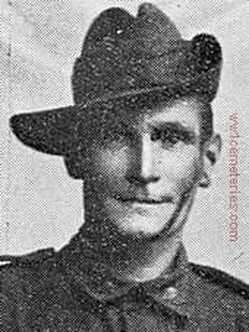
6789 Corporal
John Kenneth MacKenzie
14th Bn. Australian Infantry, A. I. F.
25th September 1917, aged 43,
Plot XIX. C. 19.
Son of James and Elizabeth Gray Mackenzie; husband of May Mackenzie, of Urana, New South Wales. Native of Blairgowrie, Perthshire, Scotland.
A storekeper prior to enlisting, he embarked from Sydney aboard SS Port Napier on 17 November 1916. He was wounded in action on 25 September 1917, during the Third Battle of Ypres, Belgium, and died later the same day of a throat wound at the 10th Casualty Clearing Station, Belgium, aged 43.
John (Jack) Kenneth Mackenzie was born at Blairgowrie, Perthshire, Scotland, in 1879. Before he emigrated to Australia he had been apprenticed as a gardener for 4 years, on the 7th Duke of Atholl's estate, and served for 3 years as Pipe Major of the Ayrshire Artillery.
He was working as a storekeeper at Urana, NSW, when he enlisted in the AIF at Cootamundra on 26 August 1916. He had married May Laird at Urana the previous year.
After initial training at the Cootamundra and Liverpool Camps, Mackenzie was assigned as a private, service number 6789, to the 22nd reinforcements for the 14th Battalion. He sailed from Sydney for England aboard SS Napier, taking his bagpipes with him. Mackenzie was made an acting lance corporal for the duration of the voyage only and reverted to private when the ship arrived at Devonport, England, on 28 January 1917.
The reinforcements moved to the 4th Training Battalion at Codford, but Mackenzie developed a severe eye infection a few days later and spent the next two months as a patient at the King George Hospital in London. He returned to training in April and finally joined his battalion in Belgium in August. Although 14th Battalion had its own band Mackenzie immediately organised an additional pipe band from some of the Scottish members of the battalion who had also brought their bagpipes with them and was appointed its Pipe Major. Mackenzie was promoted to corporal on 2 September.
At 6.30 am on 25 September Mackenzie was one of a party of men on fatigue duty near Brigade Headquarters, laying duckboards and fetching additional ammunition from the dump in anticipation of an attack planned for the following day at Zonnebeke near Ypres. He received a shrapnel wound to his face and throat. Shrapnel from the same shell killed Captain Thomas Templeton outright. Mackenzie was evacuated to 10th (British) Casualty Clearing Station at Poperinghe but he died later the same day while undergoing surgery. He was buried at the Lijssenthoek Military Cemetery.
In response to enquiries made to the Red Cross by his wife, one of Mackenzie's fellow soldiers wrote: '[he] was tall, kind and affectionate in looks ...very broad shouldered...gifted with every feature which goes to make a true-blooded highlander...he was in every way an ideal man...[He left behind] a beloved wife, for whom he had the greatest affection.'
(Text © AWM)
John Kenneth MacKenzie
14th Bn. Australian Infantry, A. I. F.
25th September 1917, aged 43,
Plot XIX. C. 19.
Son of James and Elizabeth Gray Mackenzie; husband of May Mackenzie, of Urana, New South Wales. Native of Blairgowrie, Perthshire, Scotland.
A storekeper prior to enlisting, he embarked from Sydney aboard SS Port Napier on 17 November 1916. He was wounded in action on 25 September 1917, during the Third Battle of Ypres, Belgium, and died later the same day of a throat wound at the 10th Casualty Clearing Station, Belgium, aged 43.
John (Jack) Kenneth Mackenzie was born at Blairgowrie, Perthshire, Scotland, in 1879. Before he emigrated to Australia he had been apprenticed as a gardener for 4 years, on the 7th Duke of Atholl's estate, and served for 3 years as Pipe Major of the Ayrshire Artillery.
He was working as a storekeeper at Urana, NSW, when he enlisted in the AIF at Cootamundra on 26 August 1916. He had married May Laird at Urana the previous year.
After initial training at the Cootamundra and Liverpool Camps, Mackenzie was assigned as a private, service number 6789, to the 22nd reinforcements for the 14th Battalion. He sailed from Sydney for England aboard SS Napier, taking his bagpipes with him. Mackenzie was made an acting lance corporal for the duration of the voyage only and reverted to private when the ship arrived at Devonport, England, on 28 January 1917.
The reinforcements moved to the 4th Training Battalion at Codford, but Mackenzie developed a severe eye infection a few days later and spent the next two months as a patient at the King George Hospital in London. He returned to training in April and finally joined his battalion in Belgium in August. Although 14th Battalion had its own band Mackenzie immediately organised an additional pipe band from some of the Scottish members of the battalion who had also brought their bagpipes with them and was appointed its Pipe Major. Mackenzie was promoted to corporal on 2 September.
At 6.30 am on 25 September Mackenzie was one of a party of men on fatigue duty near Brigade Headquarters, laying duckboards and fetching additional ammunition from the dump in anticipation of an attack planned for the following day at Zonnebeke near Ypres. He received a shrapnel wound to his face and throat. Shrapnel from the same shell killed Captain Thomas Templeton outright. Mackenzie was evacuated to 10th (British) Casualty Clearing Station at Poperinghe but he died later the same day while undergoing surgery. He was buried at the Lijssenthoek Military Cemetery.
In response to enquiries made to the Red Cross by his wife, one of Mackenzie's fellow soldiers wrote: '[he] was tall, kind and affectionate in looks ...very broad shouldered...gifted with every feature which goes to make a true-blooded highlander...he was in every way an ideal man...[He left behind] a beloved wife, for whom he had the greatest affection.'
(Text © AWM)
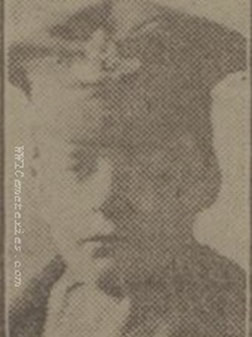
675881 Gunner
Jens Jensen Maginn
"B" Bty. 275th Bde., Royal Field Artillery
1st August 1917, aged 20.
Plot XVI. J. 4A.
Son of the late Mr. and Mrs. J. M. Jensen, of Frederikshaven, Denmark.
Jens Jensen Maginn
"B" Bty. 275th Bde., Royal Field Artillery
1st August 1917, aged 20.
Plot XVI. J. 4A.
Son of the late Mr. and Mrs. J. M. Jensen, of Frederikshaven, Denmark.
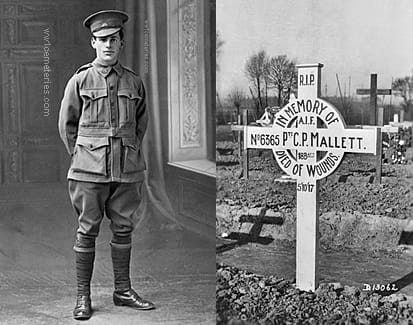
6365 Private
Cecil Percy Mallett
18th Bn. Australian Infantry, A. I. F.
5th October 1917, aged 22.
Plot XX. H. 5A.
Son of Frederick Thomas and Elizabeth Neill Mallett, of "Berwick," Wyalong St., Burwood, New South Wales.
Pte Mallett, of Burwood, NSW, was serving with the 40th Infantry, AMF, when he enlisted in the AIF on 30 October 1916. He embarked from Sydney aboard the HMAT A29 Suevic on 11 November 1916. Pte Mallett was probably fighting in the battle of Broodseinde when he was wounded in the leg by either shrapnel or bullets and was taken to the 10th Casualty Clearing Station, near Poperinghe, Belgium, by the 3rd Australian Field Ambulance. He died on admission on 5 October 1917, aged 22.
Cecil Percy Mallett
18th Bn. Australian Infantry, A. I. F.
5th October 1917, aged 22.
Plot XX. H. 5A.
Son of Frederick Thomas and Elizabeth Neill Mallett, of "Berwick," Wyalong St., Burwood, New South Wales.
Pte Mallett, of Burwood, NSW, was serving with the 40th Infantry, AMF, when he enlisted in the AIF on 30 October 1916. He embarked from Sydney aboard the HMAT A29 Suevic on 11 November 1916. Pte Mallett was probably fighting in the battle of Broodseinde when he was wounded in the leg by either shrapnel or bullets and was taken to the 10th Casualty Clearing Station, near Poperinghe, Belgium, by the 3rd Australian Field Ambulance. He died on admission on 5 October 1917, aged 22.
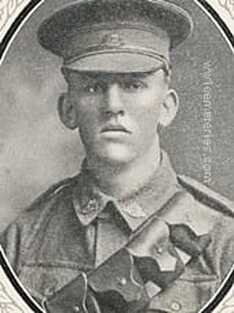
8013 Corporal
George Samuel Manfield
Australian Army Ordnance Corps
18th October 1917
Plot XXI. B. 18A.
Son of Ephraim William and Isabella Manfield, of 34, Carrington Rd., Box Hill, Victoria, Australia. Of Wodonga, Victoria.
A school teacher prior to enlisting, he embarked from Melbourne aboard HMAT Ascanius (A11) on 10 November 1915. On 8 October 1917, aged 24, he was wounded in action in the Ypres Sector, Belgium and died later that day in the 2nd Canadian Casualty Clearing Station, Belgium.
George Samuel Manfield
Australian Army Ordnance Corps
18th October 1917
Plot XXI. B. 18A.
Son of Ephraim William and Isabella Manfield, of 34, Carrington Rd., Box Hill, Victoria, Australia. Of Wodonga, Victoria.
A school teacher prior to enlisting, he embarked from Melbourne aboard HMAT Ascanius (A11) on 10 November 1915. On 8 October 1917, aged 24, he was wounded in action in the Ypres Sector, Belgium and died later that day in the 2nd Canadian Casualty Clearing Station, Belgium.
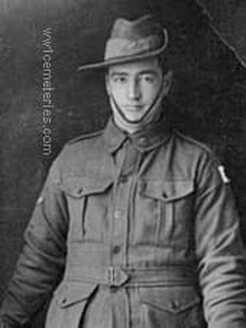
549 Private
Reginald George Marshall
24th Coy. Australian Machine Gun Corps
30th September 1917, aged 25.
Plot XXIV. B. 13A.
Son of George Herbert and Lydia Elizabeth Marshall. Native of Peel, Bathurst, New South Wales.
A native of Bathurst, NSW, Marshall worked as a farm hand prior to enlistment. He embarked with the 4th Reinforcements from Sydney aboard HMAT Anchises on 24 August 1916. Later transferring to the 24th Machine Gun Company. He died of wounds near Ypres on 30 September 1917, aged 25.
Reginald George Marshall
24th Coy. Australian Machine Gun Corps
30th September 1917, aged 25.
Plot XXIV. B. 13A.
Son of George Herbert and Lydia Elizabeth Marshall. Native of Peel, Bathurst, New South Wales.
A native of Bathurst, NSW, Marshall worked as a farm hand prior to enlistment. He embarked with the 4th Reinforcements from Sydney aboard HMAT Anchises on 24 August 1916. Later transferring to the 24th Machine Gun Company. He died of wounds near Ypres on 30 September 1917, aged 25.
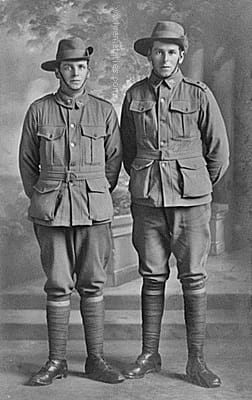
2246 Sergeant
Thomas Marshall
22nd Bn. Australian Infantry, A. I. F.
9th November 1917, aged 32.
Plot XXII. CC. 21.
Son of Robert and Jane Marshall, of Wild Duck, Victoria, Australia.
Brothers 2246 Private (Pte) Thomas Marshall (left) and 2182 Pte William Marshall, of Wild Duck, Victoria. William enlisted on 22 June 1915 in the 22nd Battalion and embarked for Europe aboard HMAT Hororata (A20) on 27 September 1915 from Melbourne. He was wounded in action in August 1916 in France, and after several months convalescence returned to the front in November. He was promoted to Lance Corporal (LCpl) on 1 March 1917. He was wounded on 3 May 1917 at the Battle of Bullecourt and died the same day, he was buried at Grevillers British Cemetery. His brother, 2246 Pte Thomas Marshall, also of the 22nd Battalion, enlisted on 15 July 1915 and embarked from Melbourne with his brother. He was promoted to Lance Corporal on 19 May 1916. He was also wounded in August 1916 and evacuated to the United Kingdom for recuperation before rejoining the battalion in November. On 1 May 1917 he was promoted to Sergeant. On 9 November 1917 he died of wounds received in action. Eight days after the death of William, another brother, Gunner (Gnr) 33456 Robert Gibson Marshall embarked from Australia aboard HMAT Shropshire (A9) with the 24th FAB. A fourth brother, Pte George Marshall embarked in 1918. Both Robert and George Marshall returned to Australia after the war.
Thomas Marshall died at No.10 C. C. S. Poperinghe of shrapnel wounds to the head and a fracture at the base of his skull. The wounds were caused by a shell burst close by Anzac House, Zonnebeke as he waited for rations.
Thomas Marshall
22nd Bn. Australian Infantry, A. I. F.
9th November 1917, aged 32.
Plot XXII. CC. 21.
Son of Robert and Jane Marshall, of Wild Duck, Victoria, Australia.
Brothers 2246 Private (Pte) Thomas Marshall (left) and 2182 Pte William Marshall, of Wild Duck, Victoria. William enlisted on 22 June 1915 in the 22nd Battalion and embarked for Europe aboard HMAT Hororata (A20) on 27 September 1915 from Melbourne. He was wounded in action in August 1916 in France, and after several months convalescence returned to the front in November. He was promoted to Lance Corporal (LCpl) on 1 March 1917. He was wounded on 3 May 1917 at the Battle of Bullecourt and died the same day, he was buried at Grevillers British Cemetery. His brother, 2246 Pte Thomas Marshall, also of the 22nd Battalion, enlisted on 15 July 1915 and embarked from Melbourne with his brother. He was promoted to Lance Corporal on 19 May 1916. He was also wounded in August 1916 and evacuated to the United Kingdom for recuperation before rejoining the battalion in November. On 1 May 1917 he was promoted to Sergeant. On 9 November 1917 he died of wounds received in action. Eight days after the death of William, another brother, Gunner (Gnr) 33456 Robert Gibson Marshall embarked from Australia aboard HMAT Shropshire (A9) with the 24th FAB. A fourth brother, Pte George Marshall embarked in 1918. Both Robert and George Marshall returned to Australia after the war.
Thomas Marshall died at No.10 C. C. S. Poperinghe of shrapnel wounds to the head and a fracture at the base of his skull. The wounds were caused by a shell burst close by Anzac House, Zonnebeke as he waited for rations.
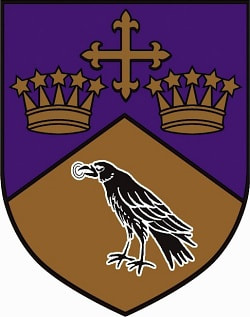
723489 Private
Percy John Martin
24th Bn. London Regiment
25th January 1917.
Plot X. D. 37A.
The information below supplied by 'The Ellesmerian Club', the alumni organisation for Ellesmere College where Percy was a pupil.
Percy John Martin
24th Bn. London Regiment
25th January 1917.
Plot X. D. 37A.
The information below supplied by 'The Ellesmerian Club', the alumni organisation for Ellesmere College where Percy was a pupil.
Percy John Martin, the only son of James and Elizabeth Martin, was born on 10th April 1897 in Clitheroe, Lancashire. By the time he entered Ellesmere College in September 1911 the family had moved to Hoole, Chester where his father had been appointed ‘Workhouse Manager’ in May 1907.
On his arrival at Ellesmere, Percy was allocated to the ‘Gordon’ dormitory and, in the next three years until he left in December 1914, he took a full and active part in all aspects of college life.
On the sports field he played football (he captained the team eventually), hockey, cricket and rugby for his dormitory over several seasons and in rugby he was also selected to represent the college, playing in the 2ndXV where he was awarded his Colours. When he left a commentator in The Ellesmerian magazine summarised his performance in that year’s season: ”has speed but no idea when to pass. Should cultivate a hand off. Better in the wing than in the centre.”
Percy also seems to have had quite a talent for athletics as records show that he took part in many different heats from the 100 yards through to the 440 yards and the half mile, coming first in the latter in the finals.
He was confirmed during his time at the college, was appointed a Prefect and became an active member of the Debating Society. He sat his Oxford Local Preliminary Exams in 1912 and he was awarded various prizes at Speech Day in 1912 and 1914. After he left in December 1914 he took up employment at the Chester offices of the Royal Assurance Company prior to his joining Lloyds Bank, Chester as a clerk.
He enlisted into the 2/5th Battalion, the East Kent Regiment (‘The Buffs’) as Private Martin, Service No.4074 at Chester on 9th December 1915.In August that year he was transferred to the 1/ 24th Battalion, the County of London Battalion (the Queens) in the rank of Private, Service No. 6969 and went overseas to the front line in France.
Percy died on 25th January 1917 in the No.3 Canadian Casualty Clearing station of Bronchial Pneumonia. He was buried in Lijssenthoiek Military Cemetery and was awarded the Victory Medal and the British War Medal.
At a meeting of the Board of Guardians for the Chester Workhouse the clerk recorded that those acquainted with Percy knew “what a fine young fellow he was. He was shy and modest but one only had to know him to realise what a splendid character he had. Not only had his father lost a good son but the nation was poorer for the loss of such a promising young fellow.”
On his arrival at Ellesmere, Percy was allocated to the ‘Gordon’ dormitory and, in the next three years until he left in December 1914, he took a full and active part in all aspects of college life.
On the sports field he played football (he captained the team eventually), hockey, cricket and rugby for his dormitory over several seasons and in rugby he was also selected to represent the college, playing in the 2ndXV where he was awarded his Colours. When he left a commentator in The Ellesmerian magazine summarised his performance in that year’s season: ”has speed but no idea when to pass. Should cultivate a hand off. Better in the wing than in the centre.”
Percy also seems to have had quite a talent for athletics as records show that he took part in many different heats from the 100 yards through to the 440 yards and the half mile, coming first in the latter in the finals.
He was confirmed during his time at the college, was appointed a Prefect and became an active member of the Debating Society. He sat his Oxford Local Preliminary Exams in 1912 and he was awarded various prizes at Speech Day in 1912 and 1914. After he left in December 1914 he took up employment at the Chester offices of the Royal Assurance Company prior to his joining Lloyds Bank, Chester as a clerk.
He enlisted into the 2/5th Battalion, the East Kent Regiment (‘The Buffs’) as Private Martin, Service No.4074 at Chester on 9th December 1915.In August that year he was transferred to the 1/ 24th Battalion, the County of London Battalion (the Queens) in the rank of Private, Service No. 6969 and went overseas to the front line in France.
Percy died on 25th January 1917 in the No.3 Canadian Casualty Clearing station of Bronchial Pneumonia. He was buried in Lijssenthoiek Military Cemetery and was awarded the Victory Medal and the British War Medal.
At a meeting of the Board of Guardians for the Chester Workhouse the clerk recorded that those acquainted with Percy knew “what a fine young fellow he was. He was shy and modest but one only had to know him to realise what a splendid character he had. Not only had his father lost a good son but the nation was poorer for the loss of such a promising young fellow.”
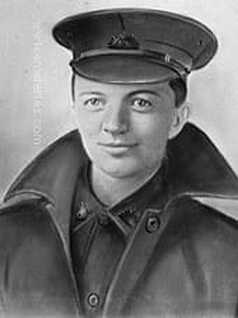
3447 Private
Ernest Albert McCormack
55th Bn. Australian Infantry, A. I. F.
20th October 1917, aged 28.
Plot XXV.F. 17.
From Brookside, Vic. Pte McCormack an engine driver before enlistment enlisted in Darlinghurst, NSW on 4 January 1917 and embarked from Sydney aboard HMAT Anchises on 24 January 1917. He died of wounds in Belgium 20 October 1917 aged 28 years. His brother 2845 Pte. John Joseph McCormack served with 38th Battalion and returned to Australia on 15 April 1917.
Ernest McCormack was hit in the throat by shrapnel, he succumbed to these wounds at No.10 C. C. S., Poperinghe the same day.
Ernest Albert McCormack
55th Bn. Australian Infantry, A. I. F.
20th October 1917, aged 28.
Plot XXV.F. 17.
From Brookside, Vic. Pte McCormack an engine driver before enlistment enlisted in Darlinghurst, NSW on 4 January 1917 and embarked from Sydney aboard HMAT Anchises on 24 January 1917. He died of wounds in Belgium 20 October 1917 aged 28 years. His brother 2845 Pte. John Joseph McCormack served with 38th Battalion and returned to Australia on 15 April 1917.
Ernest McCormack was hit in the throat by shrapnel, he succumbed to these wounds at No.10 C. C. S., Poperinghe the same day.
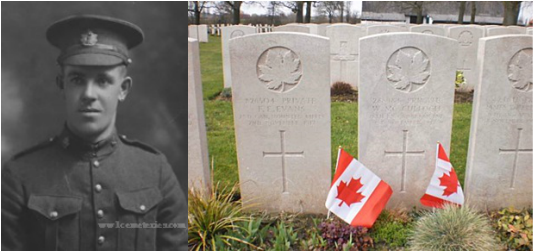
288984 Private
Wallace McCulloch
78th Bn. Canadian Infantry
1st November 1917
Plot XXI. CC. 20.
Wallace McCulloch was born in Paisley, Ontario in the year 1895, which was a small community outside Southampton on the shores of Lake Huron. The Saugeen River flowed through the town and Wallace and his siblings had played on its banks .There had been ten children born into this family though three died during childhood and their names appear on a stone in the local cemetery which also records the names of James McCulloch and Margaret Strachan, their parents, who had both been born in Scotland. Wallace worked as a farm hand on another family farm ( he was 20 years old) until he joined the military on Feb 23 1917 in Winnipeg. He was a member of the 78th Battalion. Wallace was killed on the 1st November 1917 during the Third battle of Ypres. He was survived by his Father, James Mc Culloch, his Mother Margaret Strachan McCulloch and siblings: Robert. Jean (Oliver), Alexander, Bessie Chaloner. Ethel Elliott and Annie Hastings.
A letter to his sister Bessie that was penned in France on October 13/17, two weeks before he was killed.
Dear Bessie:
Just a few lines tonight to let you know that all is well, but under the circumstances we can’t write these days as we are not stationary at present,
But will write again as soon as possible.
We are having very fine weather these days, it rains pretty near all the time, and cold too, there was a bit of hail with the rain today. It sure is a great country & hope we don’t have to put in the winter here. I guess the harvest will be off by this time, and hope it didn’t get the frost. We are in an old barn tonight and I see the old flail too. We will be threshing in our sleep tonight. Well I had a letter from Annie and one from Ethel the day after I got yours. They were mailed a week before yours, but haven’t got the parcel yet that Annie sent. The mail came in today, the first for a couple of days, but I was out of luck but I suppose there will be some along one of these fine days. Of course after tomorrow don’t expect we will get any mail for about a week.
Well, I think that is all for this time, and you can look for a picture of the platoon one of these fine days.
Well must close now hoping you are all well as this leaves me.
Love from Wallace.
A letter from his chaplain to his Mother, Mrs. Margaret McCulloch, confirmed his death on November 1st, 1917. The letter stated that he had been taken to a hospital on that same day of his injuries and everything possible for his recovery and comfort had been given to him. Later a burial report arrived from the Overseas Military Forces of Canada. which stated the following
Unit 78th Battalion -Winnipeg Grenadiers….Reg. No. 288984
Rank –Private Name McCulloch.W.
Date and Nature of Casualty 1-11-17
Where buried Lijssenthoek Military Cemetery (This is a recognized Military Burial Ground in Belgium)
No. of Grave…….Not yet available
Marking of Grave Temporary wooden memorial erected with all particulars of the deceased
Inscribed thereon.
Reference R.L. 25-M-5999/ R...I...F. (4)/ BMT.
N.B. All communications regarding this report should quote above number.
Extracted from Burial Records, Canadian Record Office. London.
This Burial Report contains all information at present available, but is subject to revision by this office.
4th May, 1918.
Pictures and information courtesy of great niece, Mary Jean Van Dorp
Click on images below to enlarge
Details on Bert Elliott can be found by clicking here
Wallace McCulloch
78th Bn. Canadian Infantry
1st November 1917
Plot XXI. CC. 20.
Wallace McCulloch was born in Paisley, Ontario in the year 1895, which was a small community outside Southampton on the shores of Lake Huron. The Saugeen River flowed through the town and Wallace and his siblings had played on its banks .There had been ten children born into this family though three died during childhood and their names appear on a stone in the local cemetery which also records the names of James McCulloch and Margaret Strachan, their parents, who had both been born in Scotland. Wallace worked as a farm hand on another family farm ( he was 20 years old) until he joined the military on Feb 23 1917 in Winnipeg. He was a member of the 78th Battalion. Wallace was killed on the 1st November 1917 during the Third battle of Ypres. He was survived by his Father, James Mc Culloch, his Mother Margaret Strachan McCulloch and siblings: Robert. Jean (Oliver), Alexander, Bessie Chaloner. Ethel Elliott and Annie Hastings.
A letter to his sister Bessie that was penned in France on October 13/17, two weeks before he was killed.
Dear Bessie:
Just a few lines tonight to let you know that all is well, but under the circumstances we can’t write these days as we are not stationary at present,
But will write again as soon as possible.
We are having very fine weather these days, it rains pretty near all the time, and cold too, there was a bit of hail with the rain today. It sure is a great country & hope we don’t have to put in the winter here. I guess the harvest will be off by this time, and hope it didn’t get the frost. We are in an old barn tonight and I see the old flail too. We will be threshing in our sleep tonight. Well I had a letter from Annie and one from Ethel the day after I got yours. They were mailed a week before yours, but haven’t got the parcel yet that Annie sent. The mail came in today, the first for a couple of days, but I was out of luck but I suppose there will be some along one of these fine days. Of course after tomorrow don’t expect we will get any mail for about a week.
Well, I think that is all for this time, and you can look for a picture of the platoon one of these fine days.
Well must close now hoping you are all well as this leaves me.
Love from Wallace.
A letter from his chaplain to his Mother, Mrs. Margaret McCulloch, confirmed his death on November 1st, 1917. The letter stated that he had been taken to a hospital on that same day of his injuries and everything possible for his recovery and comfort had been given to him. Later a burial report arrived from the Overseas Military Forces of Canada. which stated the following
Unit 78th Battalion -Winnipeg Grenadiers….Reg. No. 288984
Rank –Private Name McCulloch.W.
Date and Nature of Casualty 1-11-17
Where buried Lijssenthoek Military Cemetery (This is a recognized Military Burial Ground in Belgium)
No. of Grave…….Not yet available
Marking of Grave Temporary wooden memorial erected with all particulars of the deceased
Inscribed thereon.
Reference R.L. 25-M-5999/ R...I...F. (4)/ BMT.
N.B. All communications regarding this report should quote above number.
Extracted from Burial Records, Canadian Record Office. London.
This Burial Report contains all information at present available, but is subject to revision by this office.
4th May, 1918.
Pictures and information courtesy of great niece, Mary Jean Van Dorp
Click on images below to enlarge
Details on Bert Elliott can be found by clicking here
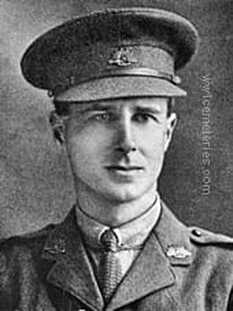
Lieutenant
Robert McNeil Crawford McKenzie
9th Bn. Australian Infantry, A. I. F.
21st September 1917, aged 29.
Plot XXIII. B. 7.
Son of Robert and Margaret Ada McKenzie, of 102, Princes Rd., Liverpool, England.
A ships purser prior to enlistment, he enlisted on 18 August 1914 and embarked with the 9th Battalion as a Private. He was returned to Australia in 1915 following injuries sustained at Gallipoli, in conjunction with neurasthenia. In May 1916 he was deemed to be healed and able to return to duty. He re-embarked in November 1916 and rejoined his unit. In May 1917 he was promoted to the rank of Lieutenant. He died of wounds sustained during the Battle of Menin Road on 21 September 1917, aged 29. His older brother, 2nd Lieutenant Samuel Aubrey McKenzie, also of the 9th Battalion, was killed in action at Pozieres on 21 August 1916, aged 29. he is buried at the Pozieres British Cemetery.
Robert McNeil Crawford McKenzie
9th Bn. Australian Infantry, A. I. F.
21st September 1917, aged 29.
Plot XXIII. B. 7.
Son of Robert and Margaret Ada McKenzie, of 102, Princes Rd., Liverpool, England.
A ships purser prior to enlistment, he enlisted on 18 August 1914 and embarked with the 9th Battalion as a Private. He was returned to Australia in 1915 following injuries sustained at Gallipoli, in conjunction with neurasthenia. In May 1916 he was deemed to be healed and able to return to duty. He re-embarked in November 1916 and rejoined his unit. In May 1917 he was promoted to the rank of Lieutenant. He died of wounds sustained during the Battle of Menin Road on 21 September 1917, aged 29. His older brother, 2nd Lieutenant Samuel Aubrey McKenzie, also of the 9th Battalion, was killed in action at Pozieres on 21 August 1916, aged 29. he is buried at the Pozieres British Cemetery.
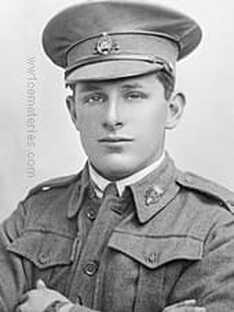
3867 Private
Alec James McLaren
8th Bn. Australian Infantry, A. I. F.
13th* October 1916, aged 20.
Plot X. B. 34.
Son of William and Edith McLaren, of Boort, Victoria, Australia. Native of Victoria, Australia.
A 19 year old timber trade worker prior to enlisting on 17 July 1915, he embarked for overseas with the 12th Reinforcements from Adelaide on 23 November 1915 aboard HMAT Ceramic. While serving on the Western Front, he suffered gunshot wounds to his chest and left foot at Hill 60, a low rise on the southern flank of the Ypres Salient in Belgium. Pte McLaren died of his wounds on 13 October 1916 at No. 3 (Canadian) Casualty Clearing Station.
* Note: 3rd C.C.S. records state that he died at 7:15am on 14th October 1916, CWGC records show a date of death as 13th October.
Alec James McLaren
8th Bn. Australian Infantry, A. I. F.
13th* October 1916, aged 20.
Plot X. B. 34.
Son of William and Edith McLaren, of Boort, Victoria, Australia. Native of Victoria, Australia.
A 19 year old timber trade worker prior to enlisting on 17 July 1915, he embarked for overseas with the 12th Reinforcements from Adelaide on 23 November 1915 aboard HMAT Ceramic. While serving on the Western Front, he suffered gunshot wounds to his chest and left foot at Hill 60, a low rise on the southern flank of the Ypres Salient in Belgium. Pte McLaren died of his wounds on 13 October 1916 at No. 3 (Canadian) Casualty Clearing Station.
* Note: 3rd C.C.S. records state that he died at 7:15am on 14th October 1916, CWGC records show a date of death as 13th October.
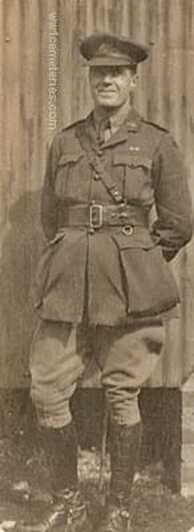
Major
Geoffrey McLaughlin, M. C.
1st Bde. Australian Field Artillery
4th November 1917, aged 30.
Plot XXI. EE. 2.
Son of John and Ada McLaughlin, of "Tanks," Evans St., Waverley, Sydney, New South Wales. Native of Sydney.
A Captain (Capt) in the Australian Field Artillery with four years’ service prior to the start of First World War he embarked with the 1st Field Artillery Brigade from Sydney on 18 October 1914 aboard HMAT Argyllshire (A8) for Egypt. During service at Gallipoli he suffered jaundice and was evacuated to Malta in early November 1915 before joining 1 FAB in Egypt following withdrawal from Gallipoli. Capt McLaughlin was awarded the Military Cross in January 1916 for distinguished service in the field and was also Mentioned in Despatches by General Sir Ian Hamilton. Capt McLaughlin was promoted to Major on 12 March 1916. The Brigade relocated to the Western Front, France, during March and April 1916. Maj Sexton was wounded in action near Flers on 1 November 1916 and was evacuated to Rouen and then to England for treatment and recuperation. In early April 1917 Maj McLaughlin rejoined 1 FAB near Amiens where he took command of the brigade with the temporary rank of Lieutenant Colonel (Lt Col) which he held until relieved by Lt Col S M Anderson DSO on 13 July 1917. Maj McLaughlin was wounded in action on a second occasion due to an attack by phosgene gas on 2 November 1917, died of these wounds two days later in No 2 Canadian Casualty Clearing Station.
Geoffrey McLaughlin, M. C.
1st Bde. Australian Field Artillery
4th November 1917, aged 30.
Plot XXI. EE. 2.
Son of John and Ada McLaughlin, of "Tanks," Evans St., Waverley, Sydney, New South Wales. Native of Sydney.
A Captain (Capt) in the Australian Field Artillery with four years’ service prior to the start of First World War he embarked with the 1st Field Artillery Brigade from Sydney on 18 October 1914 aboard HMAT Argyllshire (A8) for Egypt. During service at Gallipoli he suffered jaundice and was evacuated to Malta in early November 1915 before joining 1 FAB in Egypt following withdrawal from Gallipoli. Capt McLaughlin was awarded the Military Cross in January 1916 for distinguished service in the field and was also Mentioned in Despatches by General Sir Ian Hamilton. Capt McLaughlin was promoted to Major on 12 March 1916. The Brigade relocated to the Western Front, France, during March and April 1916. Maj Sexton was wounded in action near Flers on 1 November 1916 and was evacuated to Rouen and then to England for treatment and recuperation. In early April 1917 Maj McLaughlin rejoined 1 FAB near Amiens where he took command of the brigade with the temporary rank of Lieutenant Colonel (Lt Col) which he held until relieved by Lt Col S M Anderson DSO on 13 July 1917. Maj McLaughlin was wounded in action on a second occasion due to an attack by phosgene gas on 2 November 1917, died of these wounds two days later in No 2 Canadian Casualty Clearing Station.
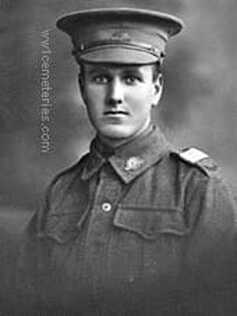
3201 Private
Keith Murdoch McLeod
50th Bn. Australian Infantry, A. I. F.
26th September 1917, aged 20.
Plot XXIII. A. 9.
Son of Peter and Mary McLeod, of Broken Hill, New South Wales.
An upholsterer prior to enlistment, he embarked with the 8th Reinforcements on HMAT Berrima (A35) on 16 December 1916. On 26 September 1917 he died of wounds received at Ypres, Belgium; he was aged 20 years.
Keith Murdoch McLeod
50th Bn. Australian Infantry, A. I. F.
26th September 1917, aged 20.
Plot XXIII. A. 9.
Son of Peter and Mary McLeod, of Broken Hill, New South Wales.
An upholsterer prior to enlistment, he embarked with the 8th Reinforcements on HMAT Berrima (A35) on 16 December 1916. On 26 September 1917 he died of wounds received at Ypres, Belgium; he was aged 20 years.
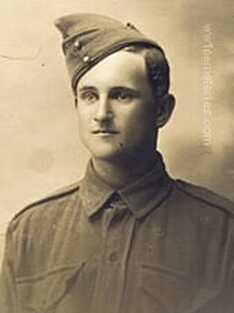
758 Sergeant
Norman Edward McPhee
46th Bn. Australian Infantry, A. I. F.
27th September 1917, aged 21.
Plot XXIII. A. 13A.
Son of William and Mary McPhee, of Goldsmith St., Hamilton, Victoria, Australia.
Sgt McPhee, from Hamilton, Victoria, was 18 years old when he enlisted in September 1914. He died of wounds on 27 September 1917.
Norman Edward McPhee
46th Bn. Australian Infantry, A. I. F.
27th September 1917, aged 21.
Plot XXIII. A. 13A.
Son of William and Mary McPhee, of Goldsmith St., Hamilton, Victoria, Australia.
Sgt McPhee, from Hamilton, Victoria, was 18 years old when he enlisted in September 1914. He died of wounds on 27 September 1917.
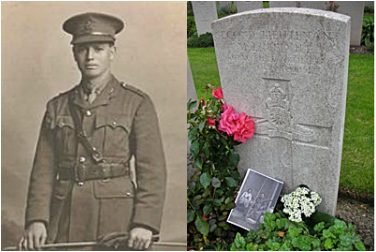
Second Lieutenant
Melvill Leopold Melvill
108th Bty. Royal Field Artillery
31st October 1917
Plot XXI. AA. 16.
Son of Leopold Francis Melvill and Mary Kate White of 48 Karl Street Jeppestown Johannesburg. Brother of Pera Haupt; Francis Leopold Melvill and Bramley Melvill. He was nicknamed Cuckoo
At Jeppe School, Johannesburg, South Africa, where he was admitted in January 1908, they now have the original war medals won by Cuckoo and the original letter from the Royal Army informing Cuckoo’s family of his death.
He left school in December 1915. He was a Second Lieutenant in 108 Bty., Royal Field Artillery who died on Wednesday, 31st October 1917. He was buried in Lijssenthoek Military Cemetery, Poperinghe in grave XXI.AA. 16.
7 months before he died, in a letter to a teacher from his school, he writes:-
Officer Cadet School,
Brighton,
28th March, 1917
Dear Mr Vines,
I expect you have heard that I am back in England, and Hope to get a commission in a very short time now. I returned at the beginning of the year, and had an excellent time while on leave before joining up. The winter has been exceptionally severe, and we had a fortnight’s skating. I enjoyed it immensely in spite of several falls.
I am going through practically the same as Mr Manduell did. I read a few extracts from his letters in the magazine. I was very much amused to think of him cleaning a window in the manner of an experienced old soldier.
I ran up against an Old Boy, D. R. Chapman, and we are still together. He left about 1908. He met Mr Manduell in Amiens a short while back.
Marr and I stuck together all the while, and I am hoping to rouse him sufficiently to make him apply for admission to one of these schools. They are very short of officers, and I am sure he would get in.
We were at Loos and on the Ancre during the big battle. The Tanks went into action past our guns, and it was a very weird spectacle. The mud, however, prevented them from being as effective as they might have been. The night before I came back we were shelled out with gas-shells, and the three hours with the helmets on were about the worst I ever hope to spend. Unfortunately one shell blew the top of our dug-out on, and we had to extricate ourselves as best we could and get to the nearest gun-pit. The material damage was rather severe, but of the men only one was wounded and one gassed. I struck a very unfortunate detachment – of the eight men with the gun, we lost both N.C.O.’s and one gunner killed and three wounded. It was pretty rough work during the winter months.
One of the poems he wrote at school includes these words:
At roll-call how oft, how the rafters have rung
With applause for a comrade whose feats have been sung:
Those times we thought proudest and brightest of all,
Never dreaming that prouder yet sadder would fall.
Yet prouder we’ll be when we turn again home
From the scenes of the carnage – not all of us: some
Will be sleeping their glorious sleep where they fell,
With the roar of the guns for their passing bell.
Picture and information courtesy of great niece, Tessa Watson, nee Haupt
Melvill Leopold Melvill
108th Bty. Royal Field Artillery
31st October 1917
Plot XXI. AA. 16.
Son of Leopold Francis Melvill and Mary Kate White of 48 Karl Street Jeppestown Johannesburg. Brother of Pera Haupt; Francis Leopold Melvill and Bramley Melvill. He was nicknamed Cuckoo
At Jeppe School, Johannesburg, South Africa, where he was admitted in January 1908, they now have the original war medals won by Cuckoo and the original letter from the Royal Army informing Cuckoo’s family of his death.
He left school in December 1915. He was a Second Lieutenant in 108 Bty., Royal Field Artillery who died on Wednesday, 31st October 1917. He was buried in Lijssenthoek Military Cemetery, Poperinghe in grave XXI.AA. 16.
7 months before he died, in a letter to a teacher from his school, he writes:-
Officer Cadet School,
Brighton,
28th March, 1917
Dear Mr Vines,
I expect you have heard that I am back in England, and Hope to get a commission in a very short time now. I returned at the beginning of the year, and had an excellent time while on leave before joining up. The winter has been exceptionally severe, and we had a fortnight’s skating. I enjoyed it immensely in spite of several falls.
I am going through practically the same as Mr Manduell did. I read a few extracts from his letters in the magazine. I was very much amused to think of him cleaning a window in the manner of an experienced old soldier.
I ran up against an Old Boy, D. R. Chapman, and we are still together. He left about 1908. He met Mr Manduell in Amiens a short while back.
Marr and I stuck together all the while, and I am hoping to rouse him sufficiently to make him apply for admission to one of these schools. They are very short of officers, and I am sure he would get in.
We were at Loos and on the Ancre during the big battle. The Tanks went into action past our guns, and it was a very weird spectacle. The mud, however, prevented them from being as effective as they might have been. The night before I came back we were shelled out with gas-shells, and the three hours with the helmets on were about the worst I ever hope to spend. Unfortunately one shell blew the top of our dug-out on, and we had to extricate ourselves as best we could and get to the nearest gun-pit. The material damage was rather severe, but of the men only one was wounded and one gassed. I struck a very unfortunate detachment – of the eight men with the gun, we lost both N.C.O.’s and one gunner killed and three wounded. It was pretty rough work during the winter months.
One of the poems he wrote at school includes these words:
At roll-call how oft, how the rafters have rung
With applause for a comrade whose feats have been sung:
Those times we thought proudest and brightest of all,
Never dreaming that prouder yet sadder would fall.
Yet prouder we’ll be when we turn again home
From the scenes of the carnage – not all of us: some
Will be sleeping their glorious sleep where they fell,
With the roar of the guns for their passing bell.
Picture and information courtesy of great niece, Tessa Watson, nee Haupt
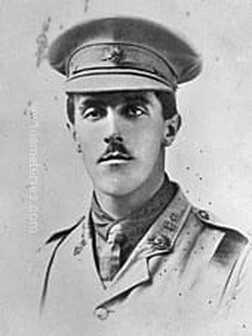
Second Lieutenant
Robert James Gordon Melville
4th Bn. Australian Infantry, A. I. F.
27th September 1916, aged 22.
Plot IX. B. 11.
Son of Andrew Gordon and Giacomina Callarina Melville, of "Glenrock," 14, Glen St., Marrickville, Sydney, New South Wales. Native of Parramatta Rd., Five Dock, Sydney.
A law clerk prior to enlistment 2nd Lt Melville embarked with the 14th Reinforcements from Sydney on HMAT Wandilla on 3 February 1916. On 27 September 1916 he died in France, aged 22, of injuries accidentally received in bombing practice.
5090 Private D. J. Ellis described the accident in which Robert Melville was mortally wounded:
"Mr Melville was instructing the bombers. One of the men threw a bomb which did not go off. Mr Melville went to examine it but as soon as he picked it up, the fuse started going off and he dropped it and ran away, when he had got about 15 yards he fell on the ground. The bomb exploded and a piece of it got him in the head and he was badly wounded. He was brought in and operated on but died about two days afterwards. He was taken away after he was wounded in a Red Cross car which was brought up for him."
Robert James Gordon Melville
4th Bn. Australian Infantry, A. I. F.
27th September 1916, aged 22.
Plot IX. B. 11.
Son of Andrew Gordon and Giacomina Callarina Melville, of "Glenrock," 14, Glen St., Marrickville, Sydney, New South Wales. Native of Parramatta Rd., Five Dock, Sydney.
A law clerk prior to enlistment 2nd Lt Melville embarked with the 14th Reinforcements from Sydney on HMAT Wandilla on 3 February 1916. On 27 September 1916 he died in France, aged 22, of injuries accidentally received in bombing practice.
5090 Private D. J. Ellis described the accident in which Robert Melville was mortally wounded:
"Mr Melville was instructing the bombers. One of the men threw a bomb which did not go off. Mr Melville went to examine it but as soon as he picked it up, the fuse started going off and he dropped it and ran away, when he had got about 15 yards he fell on the ground. The bomb exploded and a piece of it got him in the head and he was badly wounded. He was brought in and operated on but died about two days afterwards. He was taken away after he was wounded in a Red Cross car which was brought up for him."
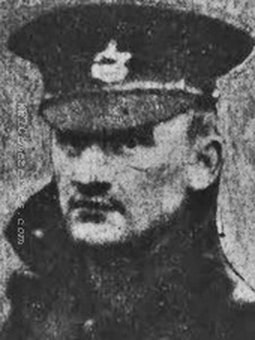
29544 Private
Joseph Metcalfe
12th Bn. The King's, (Liverpool Regiment)
7th April 1916, aged 24.
Plot V. D. 34A.
Son of Joseph and Agnes Metcalfe, of 3, West St., Nelson, Lancs.
Joseph Metcalfe
12th Bn. The King's, (Liverpool Regiment)
7th April 1916, aged 24.
Plot V. D. 34A.
Son of Joseph and Agnes Metcalfe, of 3, West St., Nelson, Lancs.
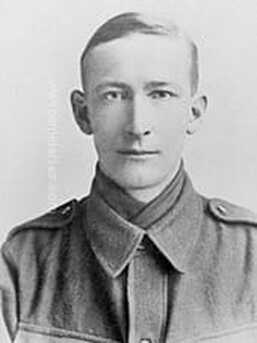
664 Corporal
Charlie Leslie Michael
24th Bn. Australian Infantry, A. I. F.
22nd September 1917, aged 23.
Plot XXIV. C. 19.
Son of Arthur and Emily Michael, of "Tooronga," 258, Latrobe Terrace, Geelong, Victoria, Australia. Native of Brisbane, Queensland.
Charlie Michael was badly wounded in the arms and legs by a shell burst whiilst in the support lines at Westhoek Ridge. He was taken to No.10 C. C. S. where he later died from multiple shell wounds.
Charlie Leslie Michael
24th Bn. Australian Infantry, A. I. F.
22nd September 1917, aged 23.
Plot XXIV. C. 19.
Son of Arthur and Emily Michael, of "Tooronga," 258, Latrobe Terrace, Geelong, Victoria, Australia. Native of Brisbane, Queensland.
Charlie Michael was badly wounded in the arms and legs by a shell burst whiilst in the support lines at Westhoek Ridge. He was taken to No.10 C. C. S. where he later died from multiple shell wounds.
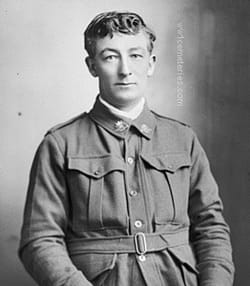
6312 Private
Charles Millington
6th Bn. Australian Infantry, A. I. F.
5th October 1917
Plot XX. F. 7A.
Son of William Thomas Millington and husband of Annie.
A farmer from Pimpinio, Victoria prior to enlistment, Pte Millington embarked with the 20th Reinforcements from Melbourne on HMAT Euripides on 11 September 1916. Whilst serving in France he was wounded in action and, due to the severity of his wounds, died on 5 October 1917.
Charles Millington
6th Bn. Australian Infantry, A. I. F.
5th October 1917
Plot XX. F. 7A.
Son of William Thomas Millington and husband of Annie.
A farmer from Pimpinio, Victoria prior to enlistment, Pte Millington embarked with the 20th Reinforcements from Melbourne on HMAT Euripides on 11 September 1916. Whilst serving in France he was wounded in action and, due to the severity of his wounds, died on 5 October 1917.
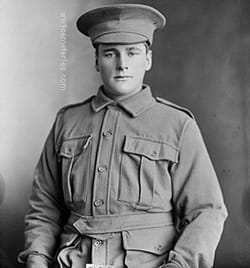
2390 Private
George Edward Mitchell
7th Bn. Australian Infantry, A. I. F.
4th October 1917, aged 19.
Plot XXV. C. 3A.
Son of Jessie Thorne and John Thorne (stepfather), of Pyramid Creek, Kerang, Victoria, Australia. Native of Kerang, Victoria.
Pte Mitchell enlisted on 4 May 1915 and embarked from Melbourne aboard HMAT Demosthenes on 16 July 1915. He died of wounds on 4 October 1917 which he received on the Menin Road in Flanders, Belgium.
George Edward Mitchell
7th Bn. Australian Infantry, A. I. F.
4th October 1917, aged 19.
Plot XXV. C. 3A.
Son of Jessie Thorne and John Thorne (stepfather), of Pyramid Creek, Kerang, Victoria, Australia. Native of Kerang, Victoria.
Pte Mitchell enlisted on 4 May 1915 and embarked from Melbourne aboard HMAT Demosthenes on 16 July 1915. He died of wounds on 4 October 1917 which he received on the Menin Road in Flanders, Belgium.
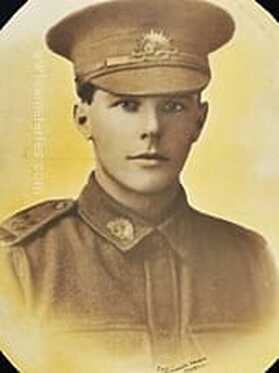
3588 Driver
Harry Mitchell, M. M.
1st Bty. 1st Bde. Australian Field Artillery
4th October 1917, aged 20.
Plot XX. D. 7A.
Son of Charles Albert and Fanny Matilda Mitchell, of Swift St., Ballina, New South Wales.
One of five brothers who served in the First World War, Gnr Mitchell worked as a textile dealer prior to enlisting on 18 August 1915. Whilst serving with 1 FAB, he was appointed Driver on 3 July 1916. Dvr Mitchell was wounded in action at Zonnebeke, Belgium, on 3 October 1917, and died of wounds the following day at the 17th Casualty Clearing Station, Lijssenthoek, aged 20 years. He was posthumously awarded the Military Medal on 2 May 1918.
Harry Mitchell, M. M.
1st Bty. 1st Bde. Australian Field Artillery
4th October 1917, aged 20.
Plot XX. D. 7A.
Son of Charles Albert and Fanny Matilda Mitchell, of Swift St., Ballina, New South Wales.
One of five brothers who served in the First World War, Gnr Mitchell worked as a textile dealer prior to enlisting on 18 August 1915. Whilst serving with 1 FAB, he was appointed Driver on 3 July 1916. Dvr Mitchell was wounded in action at Zonnebeke, Belgium, on 3 October 1917, and died of wounds the following day at the 17th Casualty Clearing Station, Lijssenthoek, aged 20 years. He was posthumously awarded the Military Medal on 2 May 1918.
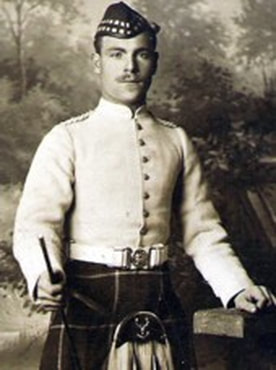
10055 Corporal
Robert Morrison
8th Bn. Seaforth Highlanders
23rd August 1917
Plot XVIII. A. 3A.
Picture courtesy of Charlie Morrison grandson of this soldier
Robert Morrison
8th Bn. Seaforth Highlanders
23rd August 1917
Plot XVIII. A. 3A.
Picture courtesy of Charlie Morrison grandson of this soldier
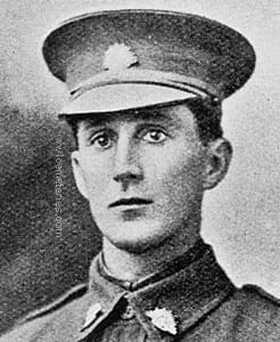
2952 Company Sergeant Major
Victor Walter Mossop
32nd Bn. Australian Infantry, A. I. F.
15th October 1917, aged 25.
Plot XXI. F. 3A.
Son of James and Emily Mossop, of Bertie St., Hind marsh West, South Australia.
A draper from West Hindmarsh, South Australia, prior to enlistment, he embarked with the 6th Reinforcements from Adelaide on 11 April 1916 aboard HMAT Aeneas (A60) for Suez. While in Egypt he was appointed Acting Corporal on 9 June 1916 and two weeks later the battalion relocated to the Western Front, France. In the following 12 months he progressed through the ranks and was promoted to Company Sergeant Major (CSM) on 2 June 1917. CSM Mossop was wounded in action near Zonnebeke, Belgium, on 12 October 1917 and died of these wounds three days later in No 2 Canadian Casualty Clearing Station. He was aged 25 years.
Victor Walter Mossop
32nd Bn. Australian Infantry, A. I. F.
15th October 1917, aged 25.
Plot XXI. F. 3A.
Son of James and Emily Mossop, of Bertie St., Hind marsh West, South Australia.
A draper from West Hindmarsh, South Australia, prior to enlistment, he embarked with the 6th Reinforcements from Adelaide on 11 April 1916 aboard HMAT Aeneas (A60) for Suez. While in Egypt he was appointed Acting Corporal on 9 June 1916 and two weeks later the battalion relocated to the Western Front, France. In the following 12 months he progressed through the ranks and was promoted to Company Sergeant Major (CSM) on 2 June 1917. CSM Mossop was wounded in action near Zonnebeke, Belgium, on 12 October 1917 and died of these wounds three days later in No 2 Canadian Casualty Clearing Station. He was aged 25 years.
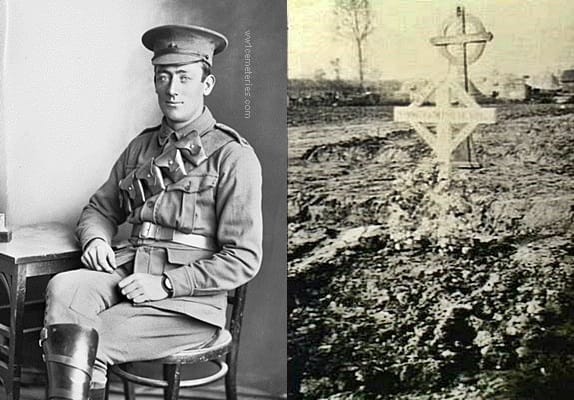
1067 Corporal
Michael Patrick Mulcahy, D. C. M.
2nd Div. Signal Coy. Australian Engineers
31st October 1917, aged 26.
Plot XXI. AA. 17.
Son of Thomas Timothy and Maria Mulcahy, of 5, Brisbane St., Ascot Vale, Victoria, Australia. Native of Boosey, Victoria.
Pte Mulcahy enlisted on 29 March 1915 and embarked from Melbourne aboard HMAT Port Macquarie on 4 June 1915. He was awarded the Distinguished Conduct Medal (DCM) on 26 September 1916 at Pozieres in France. He later served as a corporal and received a gun shot wound to the head at Birr Cross Roads near Hooge on 31 October 1917. He died later the same day.
Michael Patrick Mulcahy, D. C. M.
2nd Div. Signal Coy. Australian Engineers
31st October 1917, aged 26.
Plot XXI. AA. 17.
Son of Thomas Timothy and Maria Mulcahy, of 5, Brisbane St., Ascot Vale, Victoria, Australia. Native of Boosey, Victoria.
Pte Mulcahy enlisted on 29 March 1915 and embarked from Melbourne aboard HMAT Port Macquarie on 4 June 1915. He was awarded the Distinguished Conduct Medal (DCM) on 26 September 1916 at Pozieres in France. He later served as a corporal and received a gun shot wound to the head at Birr Cross Roads near Hooge on 31 October 1917. He died later the same day.
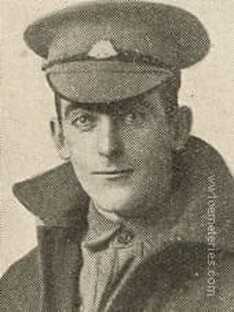
2459 Private
Gordon Mungomery
45th Bn. Australian Infantry, A. I. F.
13th October 1917, aged 28.
Plot XXI. A. 15A.
Son of Charles and Alice Harriett Mungomery, of "Overdale," Austral Avenue, North Manly, New South Wales. Native of Clyde, nr. Granville, New South Wales.
A machinist prior to enlisting, he embarked from Sydney aboard HMAT Anchises (A68) on 24 August 1916. He was wounded in action at Westhoek Ridge, Zonnebeke, Begium on 12 October 1917 and died of wounds at the 3rd Canadian Casualty Clearing Station, Belgium on 13 October 1917, aged 28.
Gordon Mungomery
45th Bn. Australian Infantry, A. I. F.
13th October 1917, aged 28.
Plot XXI. A. 15A.
Son of Charles and Alice Harriett Mungomery, of "Overdale," Austral Avenue, North Manly, New South Wales. Native of Clyde, nr. Granville, New South Wales.
A machinist prior to enlisting, he embarked from Sydney aboard HMAT Anchises (A68) on 24 August 1916. He was wounded in action at Westhoek Ridge, Zonnebeke, Begium on 12 October 1917 and died of wounds at the 3rd Canadian Casualty Clearing Station, Belgium on 13 October 1917, aged 28.
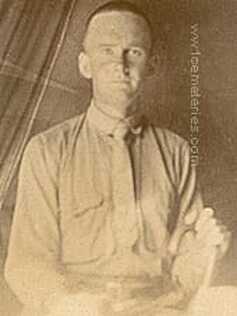
Lieutenant Colonel
James Joachim Nicholas
5th Australian Field Ambulance, Australian Army Medical Corps
20th September 1917
Plot XIX. C. 4.
James Nicholas, a medical practitioner of Colac, Victoria, embarked from Melbourne on HMAT Southern on 18 October 1914. Later promoted to the rank of Lieutenant Colonel, he was killed in action on 20 September 1917.
James Joachim Nicholas
5th Australian Field Ambulance, Australian Army Medical Corps
20th September 1917
Plot XIX. C. 4.
James Nicholas, a medical practitioner of Colac, Victoria, embarked from Melbourne on HMAT Southern on 18 October 1914. Later promoted to the rank of Lieutenant Colonel, he was killed in action on 20 September 1917.
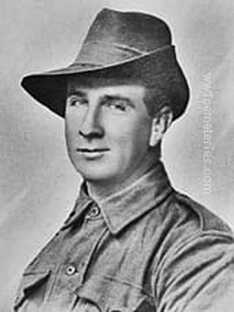
3368 Private
Arthur Marshall Nicholson
5th Bn. Australian Infantry, A. I. F.
21st September 1917, aged 30.
Plot XXIII. D. 15.
Son of the late Samuel Henry and Hannah Eliza Nicholson. Native of Brighton, Victoria, Australia.
3368 Private Arthur Marshall Nicholson was born at Brighton, Victoria, the son of Samuel Henry and Hannah Eliza Nicholson. He was working as a grocer when he enlisted in the AIF on 7 July 1915. He embarked from Melbourne for Egypt on 11 October 1915 with the 11th reinforcements of 5 Battalion. Nicholson served in Egypt until 25 March 1916 when he embarked for France, arriving at Marseilles five days later. He served in France and took part in his unit's first major action in France, at Pozieres in the Somme Valley, in July 1916. On 24 December 1916 Private Nicholson was admitted to hospital with trench feet. He was sent to England and was in hospital until May 1917. He undertook further training at Perham Downs for two months before rejoining his unit in Belgium in late August 1917. On 20 September 1917 Nicholson took part in an attack at Menin Road, near Ypres in Belgium, capturing German territory. Throughout the following day, 21 September, German artillery fire harassed the Australian positions and as the day went on became increasingly accurate. At some point during the day, Private Nicholson was hit by shrapnel in his left leg and ankle. He was first treated by the 6th Australian Field Ambulance, who then transferred him to the 17th (British) Casualty Clearing Station, where he died of his wounds. He is buried at Lijssenthoek Military Cemetery in Belgium.
Arthur Marshall Nicholson
5th Bn. Australian Infantry, A. I. F.
21st September 1917, aged 30.
Plot XXIII. D. 15.
Son of the late Samuel Henry and Hannah Eliza Nicholson. Native of Brighton, Victoria, Australia.
3368 Private Arthur Marshall Nicholson was born at Brighton, Victoria, the son of Samuel Henry and Hannah Eliza Nicholson. He was working as a grocer when he enlisted in the AIF on 7 July 1915. He embarked from Melbourne for Egypt on 11 October 1915 with the 11th reinforcements of 5 Battalion. Nicholson served in Egypt until 25 March 1916 when he embarked for France, arriving at Marseilles five days later. He served in France and took part in his unit's first major action in France, at Pozieres in the Somme Valley, in July 1916. On 24 December 1916 Private Nicholson was admitted to hospital with trench feet. He was sent to England and was in hospital until May 1917. He undertook further training at Perham Downs for two months before rejoining his unit in Belgium in late August 1917. On 20 September 1917 Nicholson took part in an attack at Menin Road, near Ypres in Belgium, capturing German territory. Throughout the following day, 21 September, German artillery fire harassed the Australian positions and as the day went on became increasingly accurate. At some point during the day, Private Nicholson was hit by shrapnel in his left leg and ankle. He was first treated by the 6th Australian Field Ambulance, who then transferred him to the 17th (British) Casualty Clearing Station, where he died of his wounds. He is buried at Lijssenthoek Military Cemetery in Belgium.
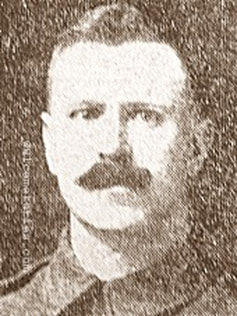
242756 Private
Fred Nuttall
1st/6th Bn. The King's, (Liverpool Regiment)
7th March 1917, aged 38.
Plot XI. B. 25.
Son of James and Jane Nuttall, of Harle Syke, Briercliffe, near Burnley, Lancs; husband of Agnes Nuttall, of 81, Burnley Rd., Harle Syke.
Fred Nuttall
1st/6th Bn. The King's, (Liverpool Regiment)
7th March 1917, aged 38.
Plot XI. B. 25.
Son of James and Jane Nuttall, of Harle Syke, Briercliffe, near Burnley, Lancs; husband of Agnes Nuttall, of 81, Burnley Rd., Harle Syke.

